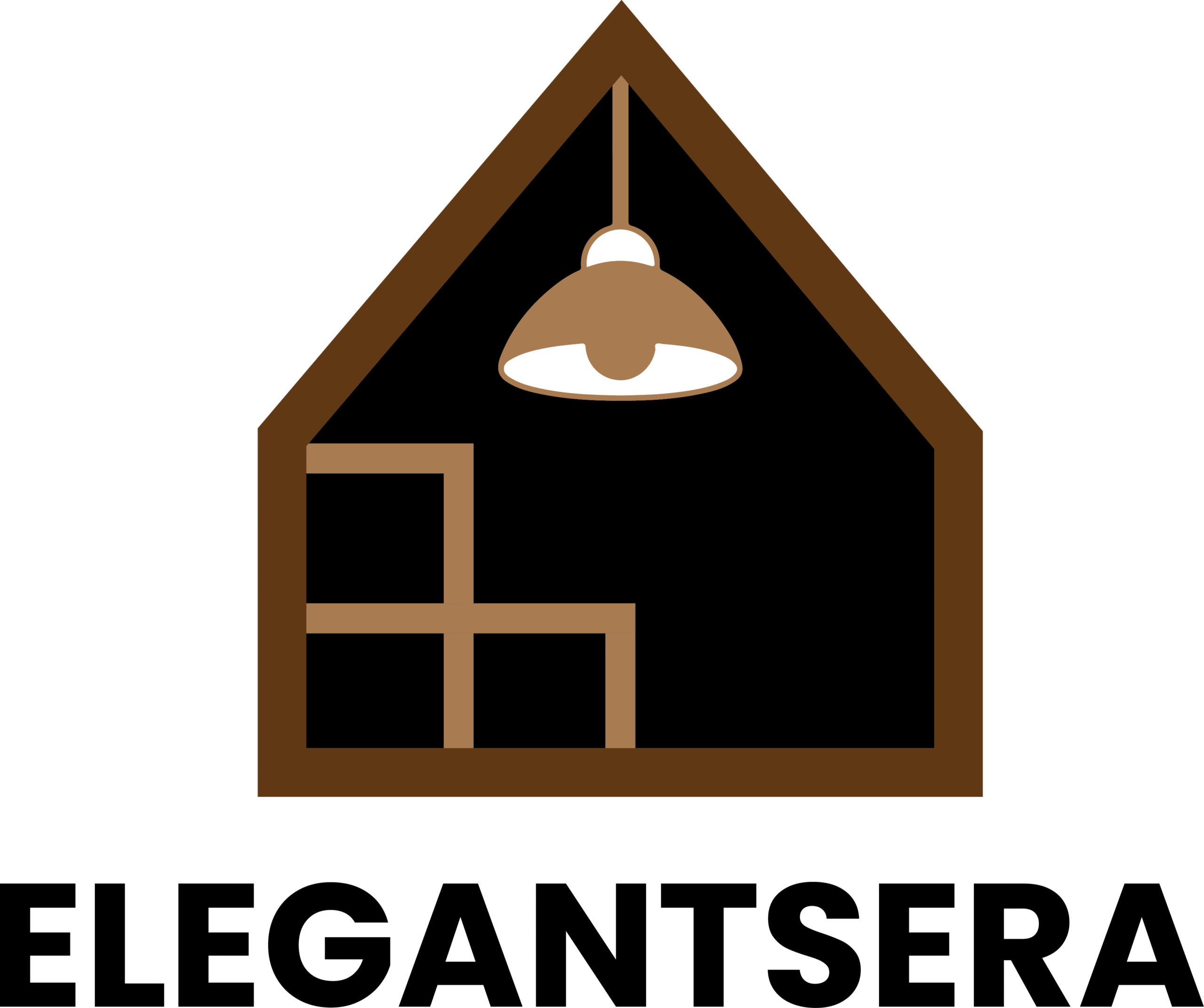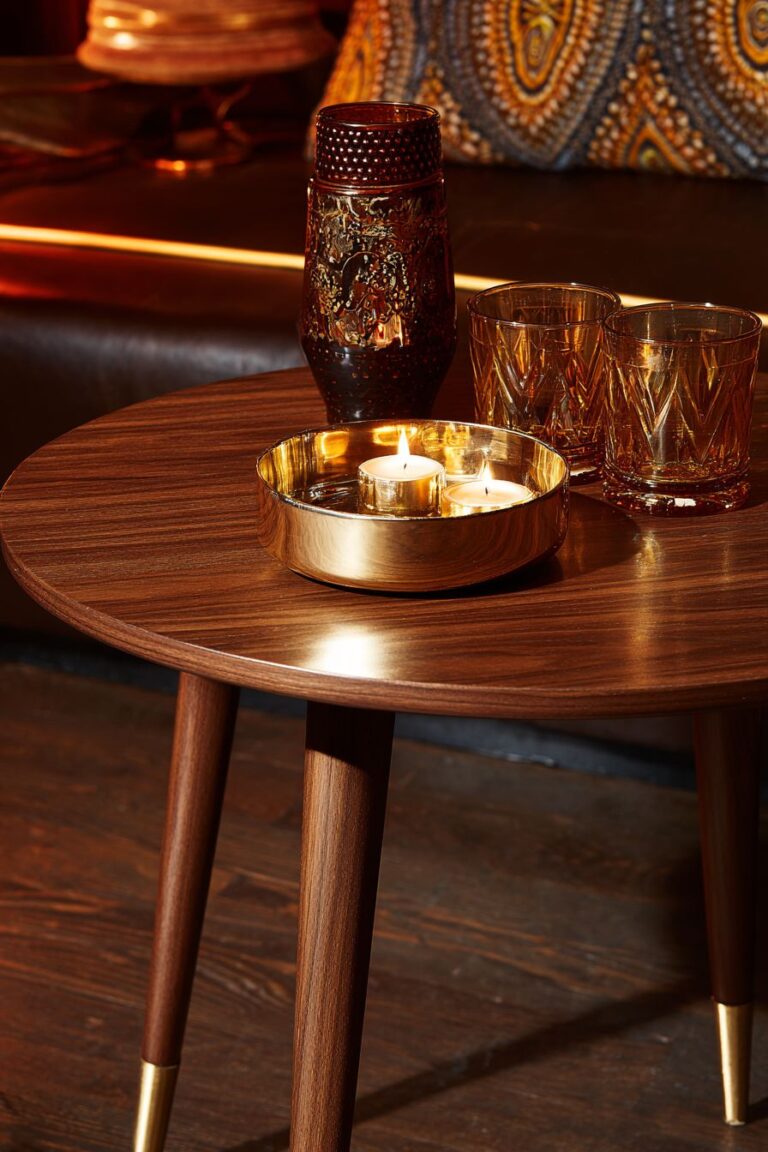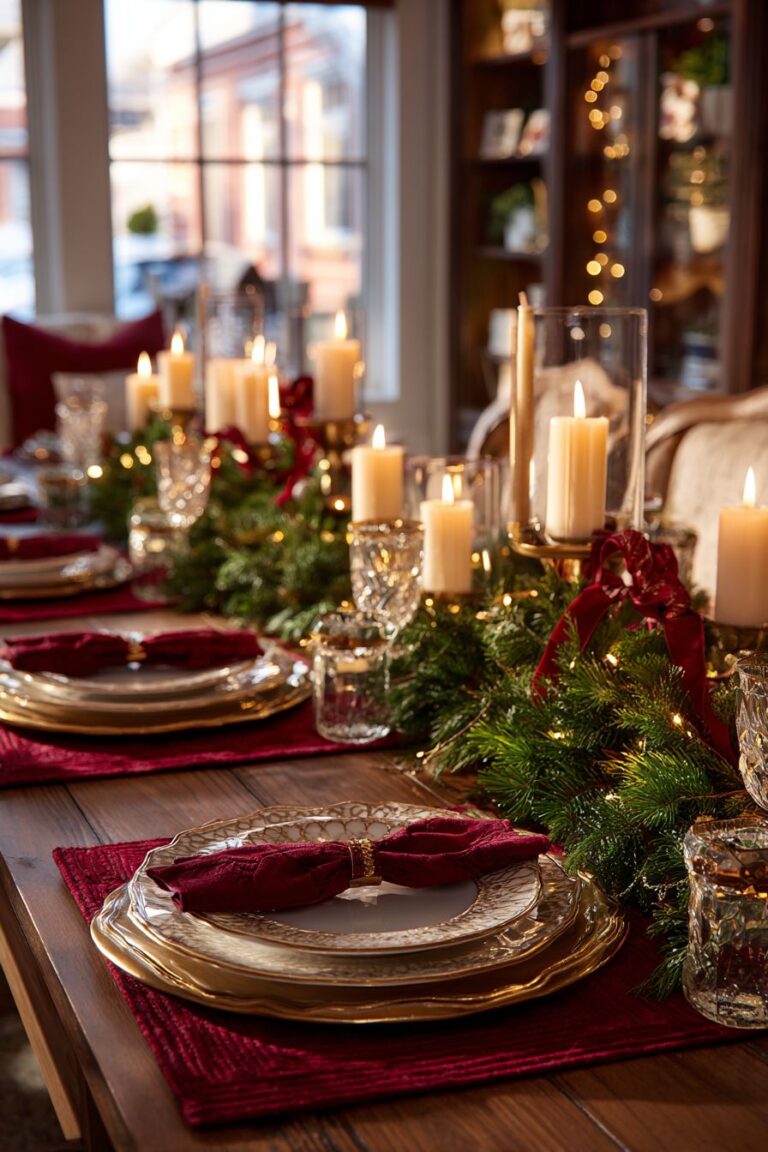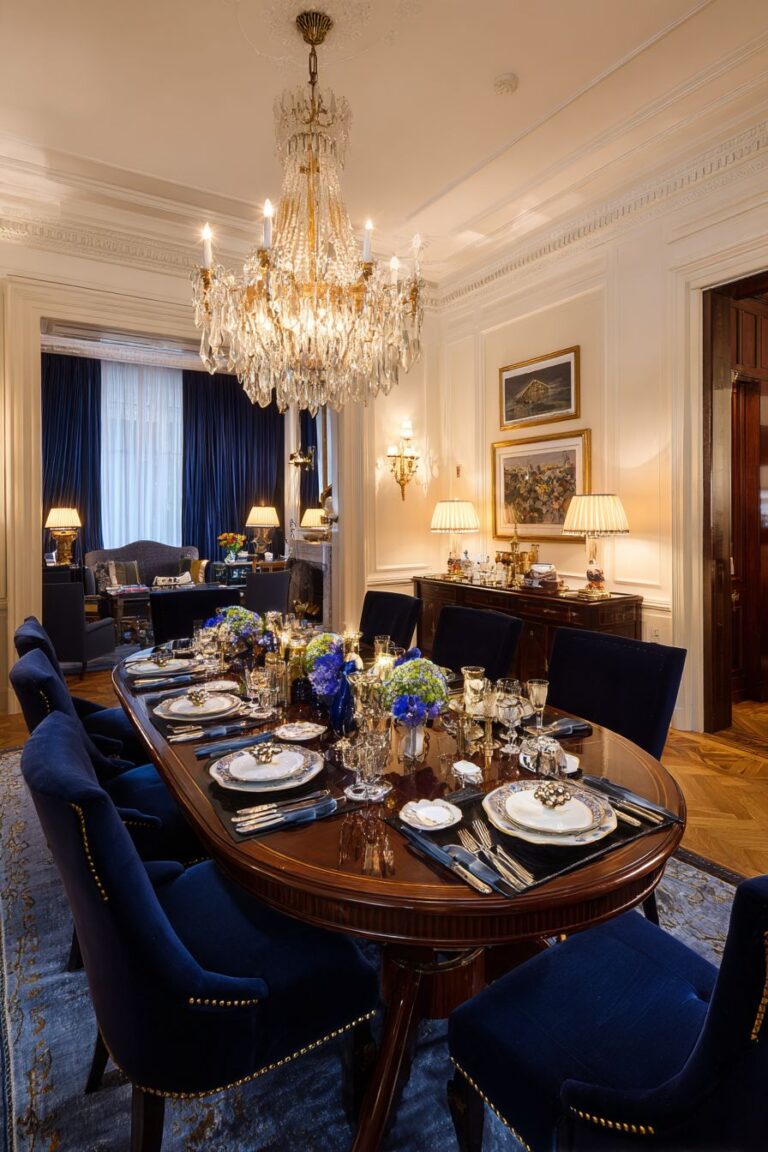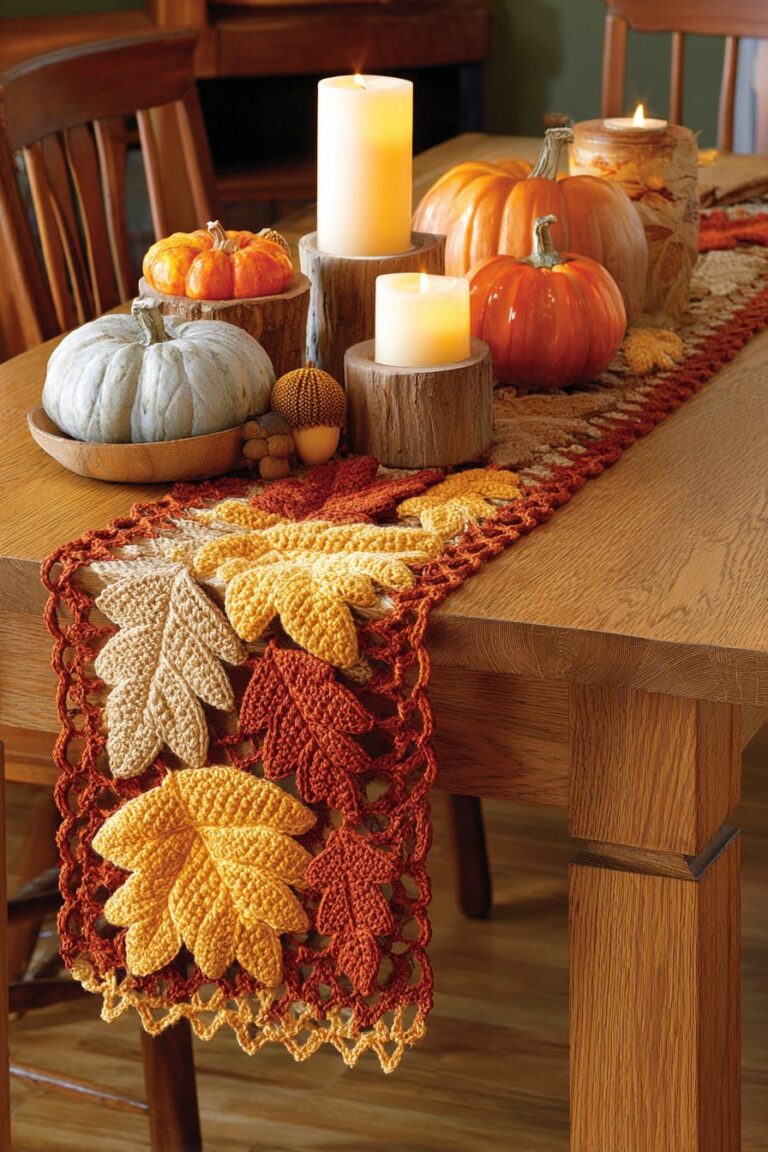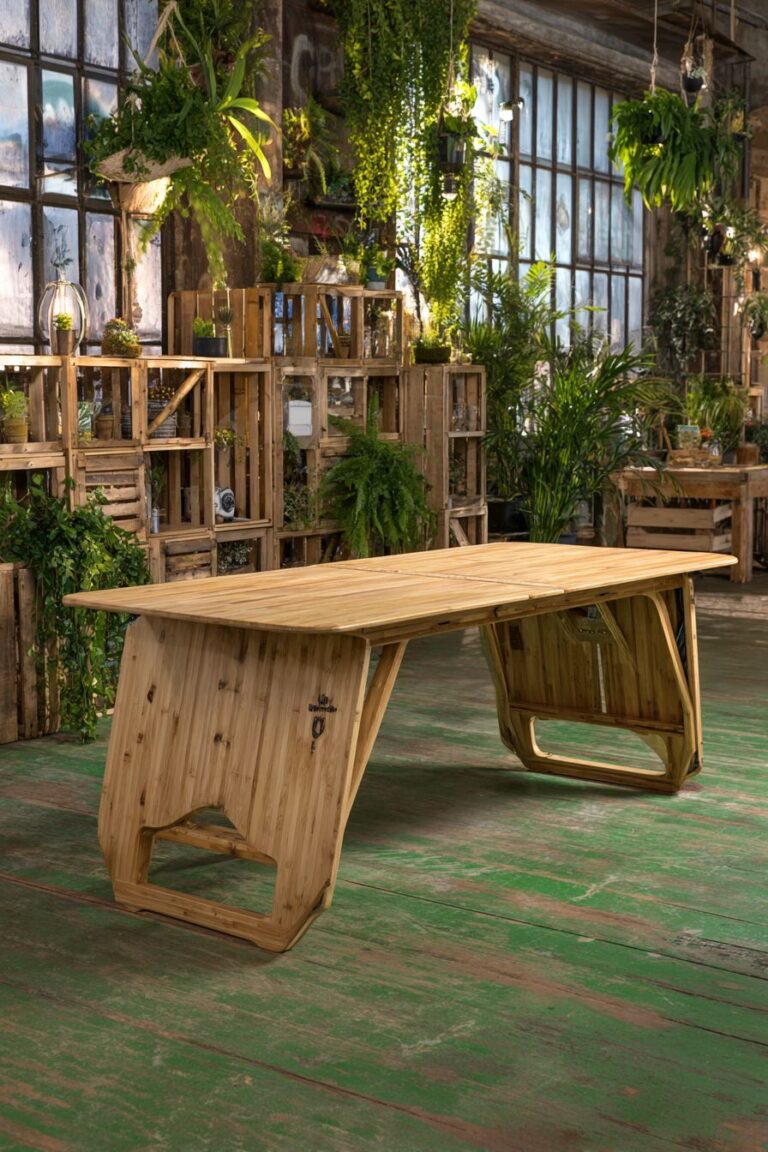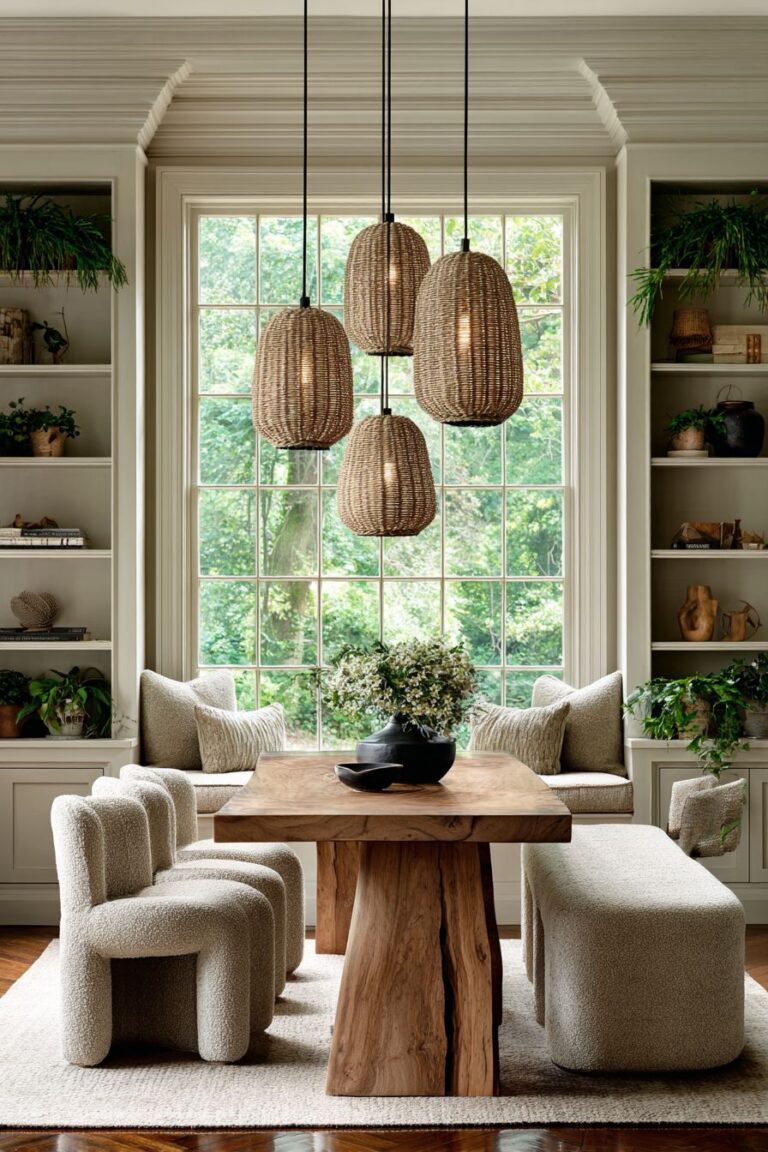20 Dining Room Decor Ideas For Every Style & Budget
The dining room serves as the heart of home entertainment and family gatherings, making thoughtful interior design essential for creating both functional and inspiring spaces. A well-designed dining room doesn’t just provide a place to eat; it creates an atmosphere that encourages conversation, celebrates special occasions, and reflects your personal style. Whether you’re hosting intimate dinner parties or enjoying casual family meals, the right design elements can transform your dining space into a welcoming haven that guests will remember long after the last course is served.
From sleek modern aesthetics to warm rustic charm, dining room design encompasses a diverse range of styles that cater to different personalities and lifestyles. The key lies in understanding how various elements—furniture, lighting, color palettes, textures, and accessories—work together to create a cohesive and inviting environment. Each design approach offers unique benefits, whether it’s maximizing space in smaller homes, creating formal elegance for special occasions, or establishing a casual atmosphere perfect for everyday living.
This comprehensive guide explores twenty distinct dining room decor concepts, each offering a unique perspective on how to create beautiful, functional dining spaces. From contemporary minimalism to eclectic vintage charm, these ideas demonstrate how thoughtful design choices can dramatically impact both the aesthetics and functionality of your dining area, ensuring every meal becomes a memorable experience.
1. Contemporary Modern Elegance
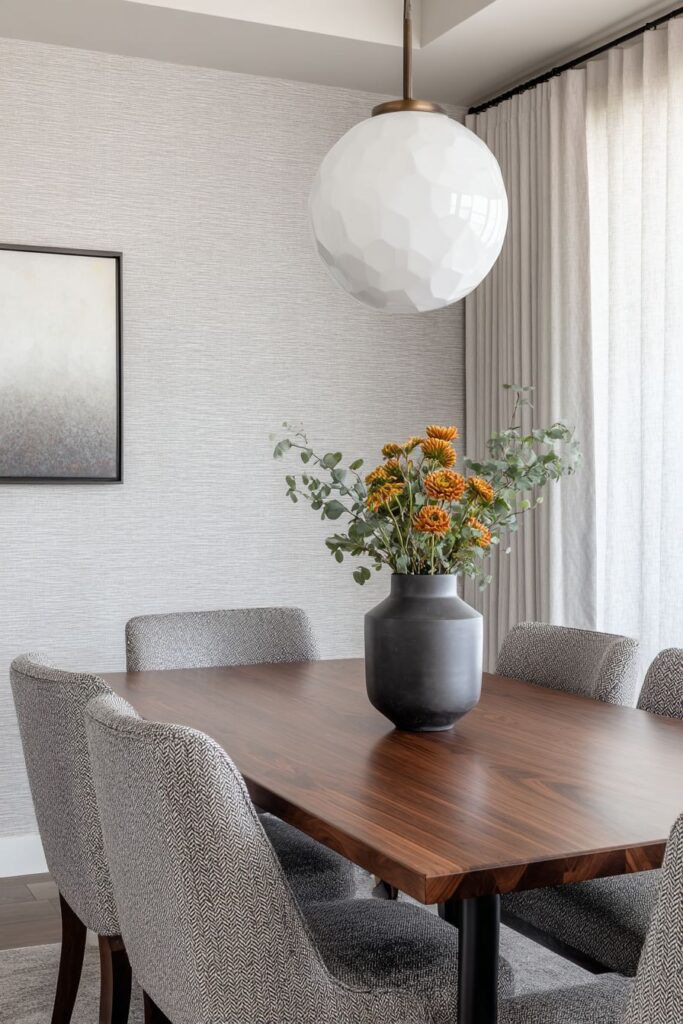
Step into a dining room where sleek sophistication meets functional beauty through carefully curated modern elements. The centerpiece, a stunning walnut dining table with black steel legs, creates a striking contrast that exemplifies contemporary design principles. The rich, warm tones of the walnut wood grain provide organic warmth against the cool, industrial precision of the powder-coated steel frame, establishing a perfect balance between natural and manufactured materials.
Surrounding this magnificent table, charcoal fabric upholstered chairs offer both comfort and visual weight, their soft textures providing a welcome counterpoint to the table’s harder surfaces. The geometric pendant light fixture in brushed brass becomes a sculptural focal point, its angular design catching and reflecting light while providing focused illumination for dining activities. This metallic accent introduces warmth without overwhelming the space’s clean aesthetic.
The neutral color palette extends throughout the room, with a textured accent wall in warm grey serving as a sophisticated backdrop that doesn’t compete with the furniture pieces. This monochromatic approach allows the quality of materials and craftsmanship to shine through, while subtle variations in texture prevent the space from feeling flat or sterile.
Professional lighting design plays a crucial role in this contemporary setting, with strategically placed sources creating subtle shadows that emphasize the material contrasts and architectural details. The interplay of light and shadow adds depth and dimension, transforming what could be a stark modern space into one that feels inviting and dynamic.
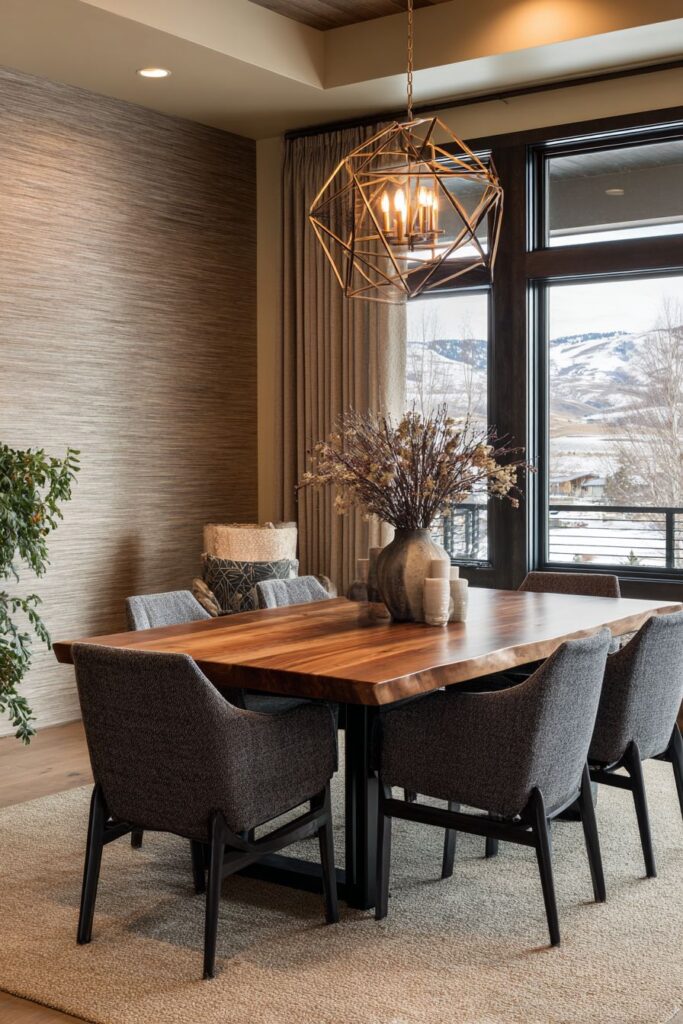
Key Design Tips:
- Choose furniture with clean lines and mixed materials for visual interest
- Incorporate geometric lighting fixtures as statement pieces
- Use a neutral color palette with textured surfaces to add depth
- Layer lighting sources to create ambiance and highlight architectural features
- Select upholstered seating in rich, dark tones for contrast and comfort
2. Traditional Formal Sophistication
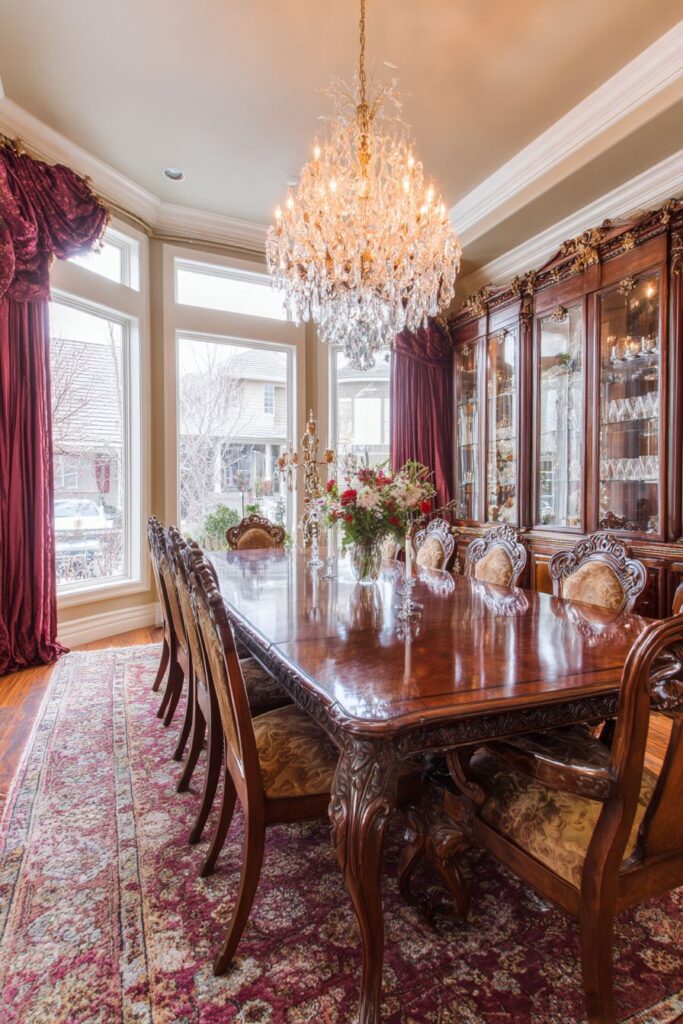
Enter a dining room that embodies timeless elegance through meticulously chosen traditional elements that speak to generations of refined taste. The centerpiece mahogany dining table, with its intricate carved details and lustrous finish, commands attention while demonstrating the artistry of classical furniture making. Each curve and flourish in the woodwork tells a story of craftsmanship, creating a piece that serves not just as furniture but as a work of art.
The classic upholstered chairs with nailhead trim exemplify traditional attention to detail, their high-quality construction and refined proportions ensuring both comfort and visual appeal. The brass nailheads catch the light, adding subtle metallic accents that complement the room’s warm color palette while reinforcing the sense of luxury and permanence that defines traditional design.
Above this elegant arrangement, a crystal chandelier provides not just illumination but theatrical drama, its faceted crystals catching and dispersing light throughout the room. This magnificent fixture serves as both a functional necessity and a decorative statement, embodying the traditional belief that everyday objects should be beautiful as well as useful.
Built-in china cabinets with glass doors showcase fine dinnerware, transforming practical storage into display opportunities that celebrate the homeowner’s collection of beautiful objects. The rich burgundy drapes frame tall windows like theatrical curtains, while a Persian area rug anchors the space with its intricate patterns and jewel tones, adding layers of visual richness that reward closer examination.
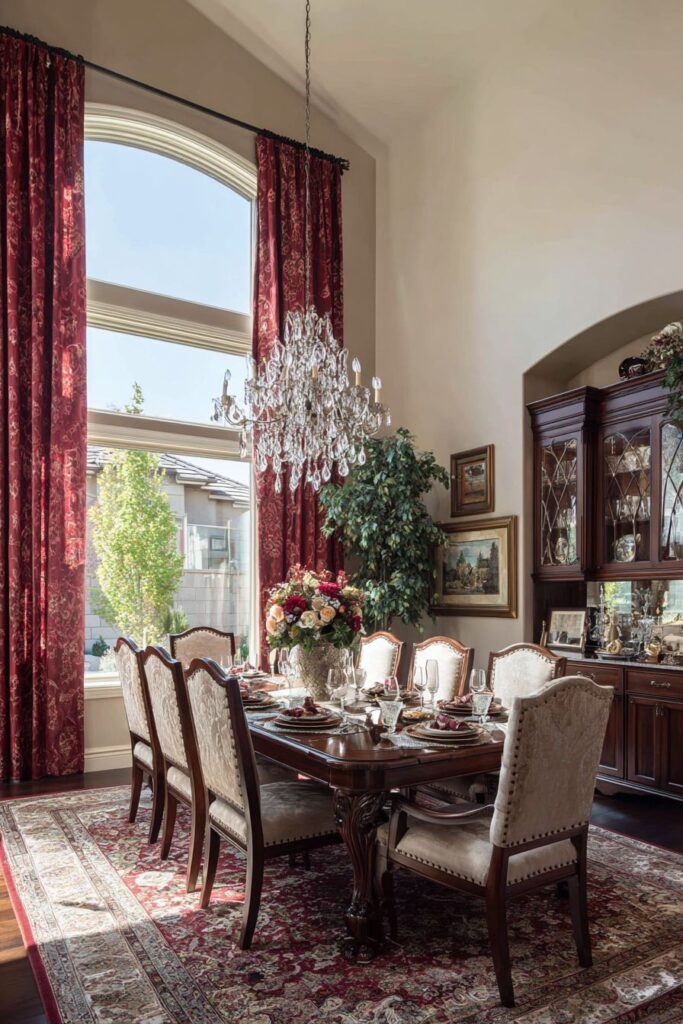
Key Design Tips:
- Invest in quality wood furniture with traditional joinery and carved details
- Use crystal chandeliers to create focal points and enhance ambient lighting
- Display fine china and collectibles in glass-front cabinetry
- Incorporate rich fabrics like velvet and silk in deep, saturated colors
- Layer Persian or Oriental rugs for authentic traditional warmth and pattern
3. Small Space Smart Solutions
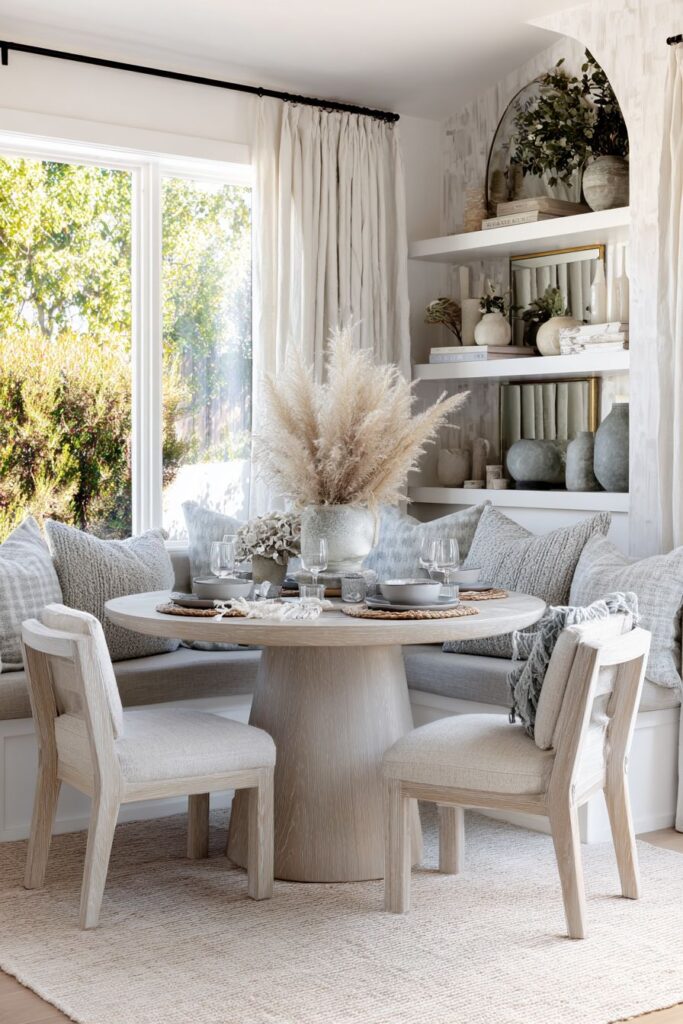
Discover how thoughtful design transforms limited square footage into a functional and beautiful dining area that maximizes every inch without sacrificing style. The round pedestal table in light oak serves as the perfect centerpiece for small spaces, its circular shape encouraging conversation while eliminating sharp corners that could impede traffic flow. The single pedestal base provides maximum legroom while taking up minimal floor space, demonstrating how smart furniture choices can dramatically improve functionality.
The corner banquette with built-in storage underneath represents innovative thinking about dual-purpose furniture, providing comfortable seating for multiple people while hiding dining linens, seasonal items, or rarely used serving pieces. This clever solution eliminates the need for additional storage furniture, freeing up precious floor space while maintaining a clean, organized appearance.
Built-in floating shelves mounted on walls display decorative items without consuming floor space, drawing the eye upward and creating visual interest at different heights. These shelves can showcase everything from plants and artwork to beautiful serving pieces, adding personality to the room while maintaining functionality.
Strategically placed mirrors work magic in small spaces, reflecting natural light and creating the illusion of expanded square footage. When positioned across from windows or light sources, mirrors can effectively double the apparent size of the room while adding sparkle and visual depth that prevents the space from feeling cramped or closed in.
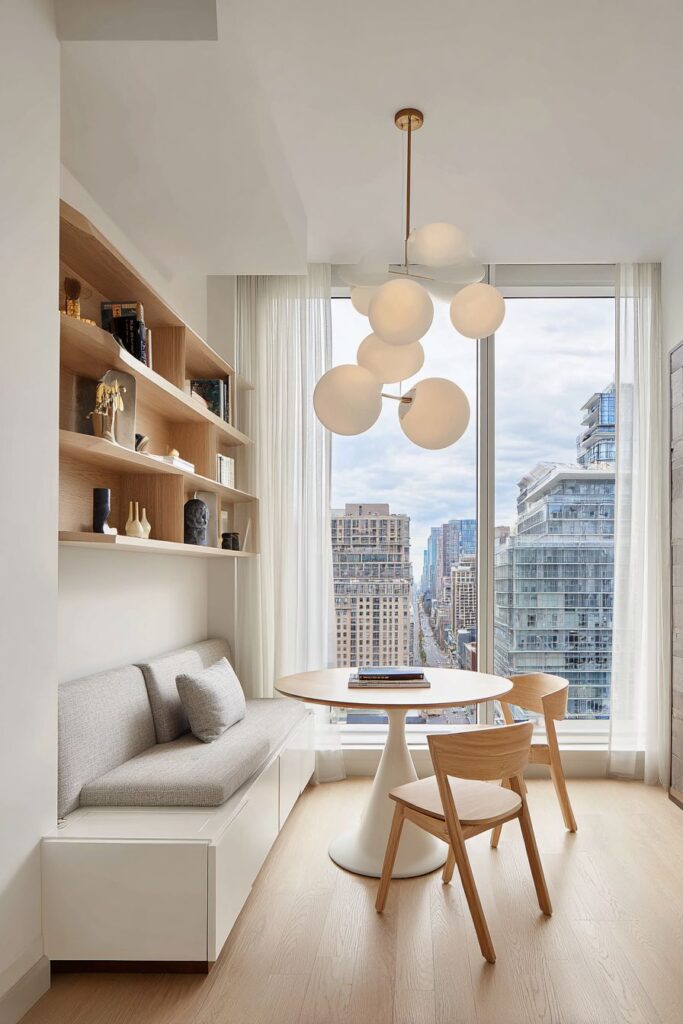
Key Design Tips:
- Choose round tables to improve traffic flow and maximize seating
- Incorporate built-in seating with hidden storage compartments
- Use floating shelves to display items without taking floor space
- Install mirrors opposite windows to reflect light and expand visual space
- Select light-colored furniture to keep the space feeling open and airy
4. Authentic Farmhouse Charm
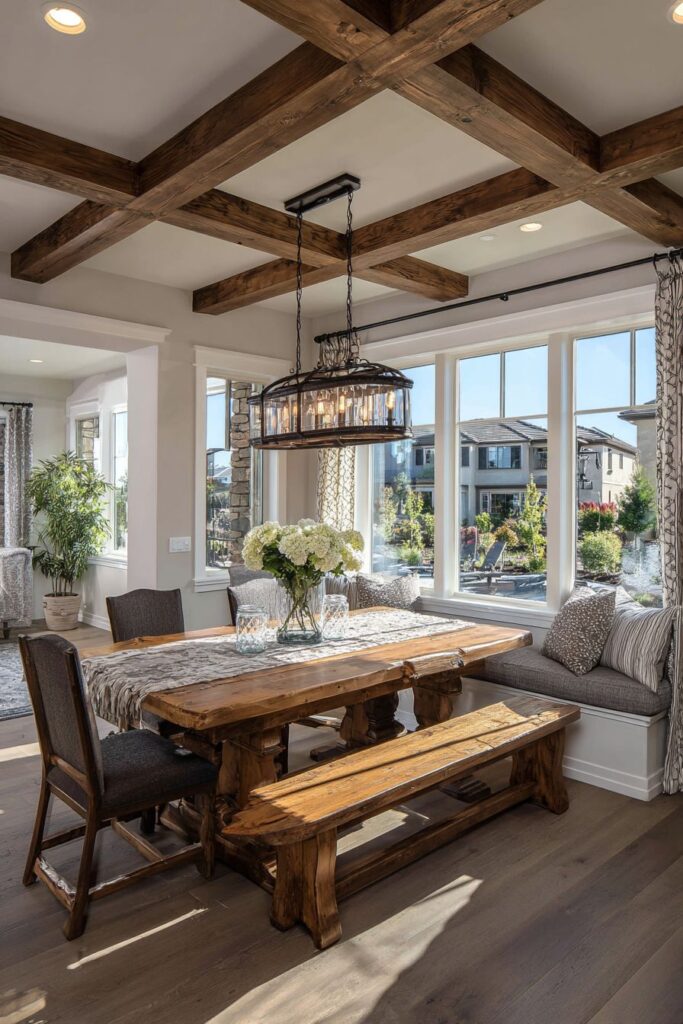
Immerse yourself in the warmth and authenticity of farmhouse design, where a reclaimed wood trestle table serves as both functional furniture and historical artifact. The visible grain patterns, nail holes, and natural imperfections in the wood tell stories of previous lives, perhaps as barn siding or old fence posts, bringing character and authenticity that new furniture simply cannot replicate. This weathered patina adds depth and visual interest while connecting the space to agricultural heritage and simpler times.
Mismatched wooden chairs surrounding the table embody the farmhouse philosophy of function over form, where pieces were collected over time rather than purchased as matching sets. Each chair brings its own personality to the gathering, creating an eclectic mix that feels organic and lived-in. This approach encourages conversation and reflects the farmhouse value of hospitality over perfection.
The vintage-inspired wagon wheel chandelier provides rustic lighting that reinforces the agricultural theme while offering practical illumination for dining activities. Its weathered metal finish and rope accents add textural interest while the Edison bulbs provide warm, amber light that enhances the cozy atmosphere and highlights the rich wood tones throughout the space.
Shiplap accent walls in soft white create a bright, clean backdrop that prevents the space from feeling too heavy or dark, while exposed wooden beams overhead add architectural interest and reinforce the rustic theme. Mason jar centerpieces and galvanized metal accessories complete the authentic farmhouse aesthetic, bringing in elements that reference rural life and traditional farming practices.
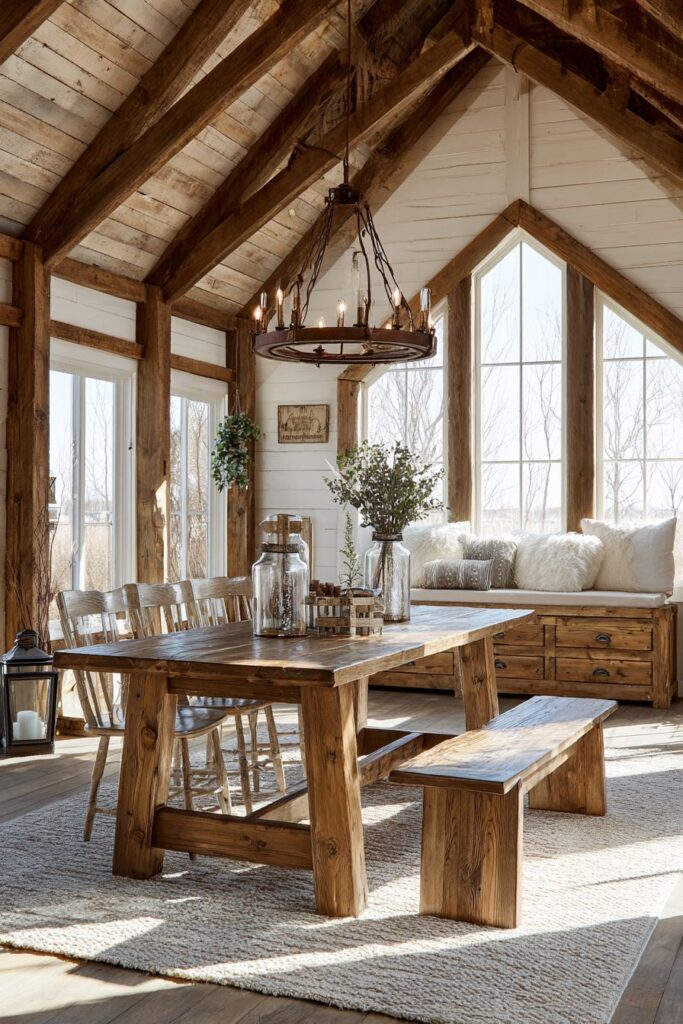
Key Design Tips:
- Select reclaimed wood furniture to add history and character
- Mix and match seating for an authentic, collected-over-time appearance
- Use vintage-inspired lighting fixtures with Edison bulbs for warm ambiance
- Incorporate shiplap or board-and-batten wall treatments for farmhouse texture
- Add galvanized metal accessories and mason jar elements for authentic details
5. Scandinavian Serene Simplicity
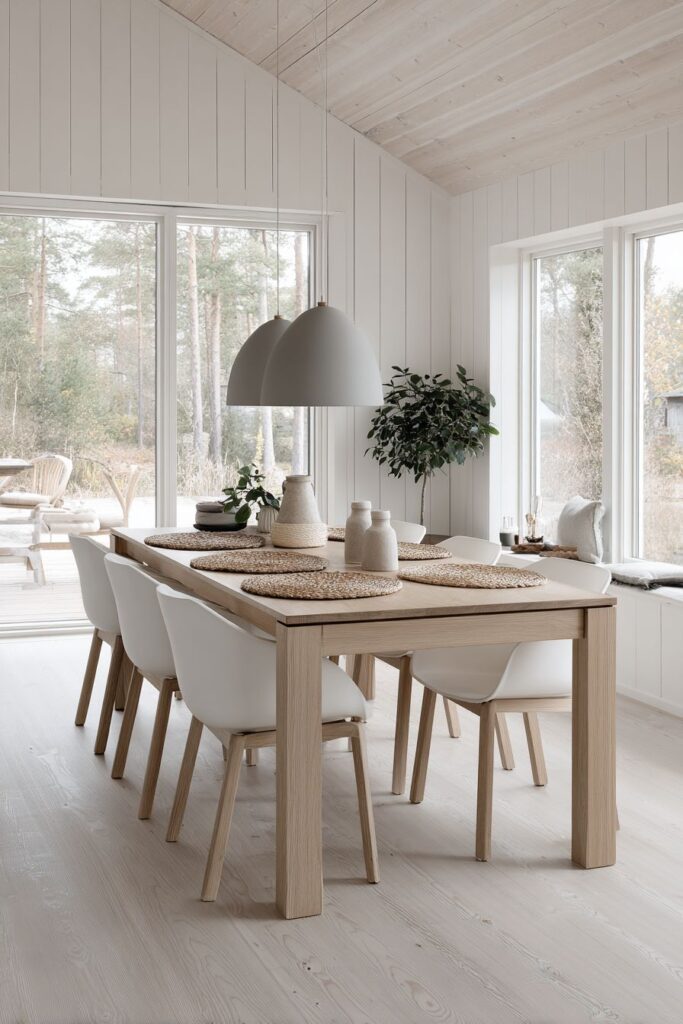
Enter a dining space that embodies the Scandinavian principle of lagom—the idea that the best life is balanced, moderate, and sustainable. The light ash wood dining table with its clean, straight lines represents the Nordic commitment to functional beauty, where every element serves a purpose while contributing to the overall aesthetic harmony. The pale wood grain adds subtle texture without overwhelming the senses, creating a calm foundation for the entire room design.
White molded plastic chairs surround the table, their sculptural forms representing mid-century Scandinavian design innovation while providing comfortable, easy-to-clean seating. These chairs, likely inspired by classics like the Eames or Panton designs, demonstrate how Scandinavian aesthetics embrace both form and function, creating pieces that are beautiful to look at and practical to use.
A simple pendant light in matte black hangs above the table, its understated design providing necessary illumination without drawing undue attention to itself. This lighting choice reflects the Scandinavian preference for functional objects with quiet elegance, pieces that serve their purpose efficiently while contributing to the overall sense of calm.
The bright white walls create a clean backdrop that maximizes the reflection of natural light, essential in Nordic countries where daylight hours can be limited. Large windows without treatments flood the space with soft, diffused light that changes throughout the day, connecting the interior to the natural world and seasonal rhythms that are central to Scandinavian living philosophy.
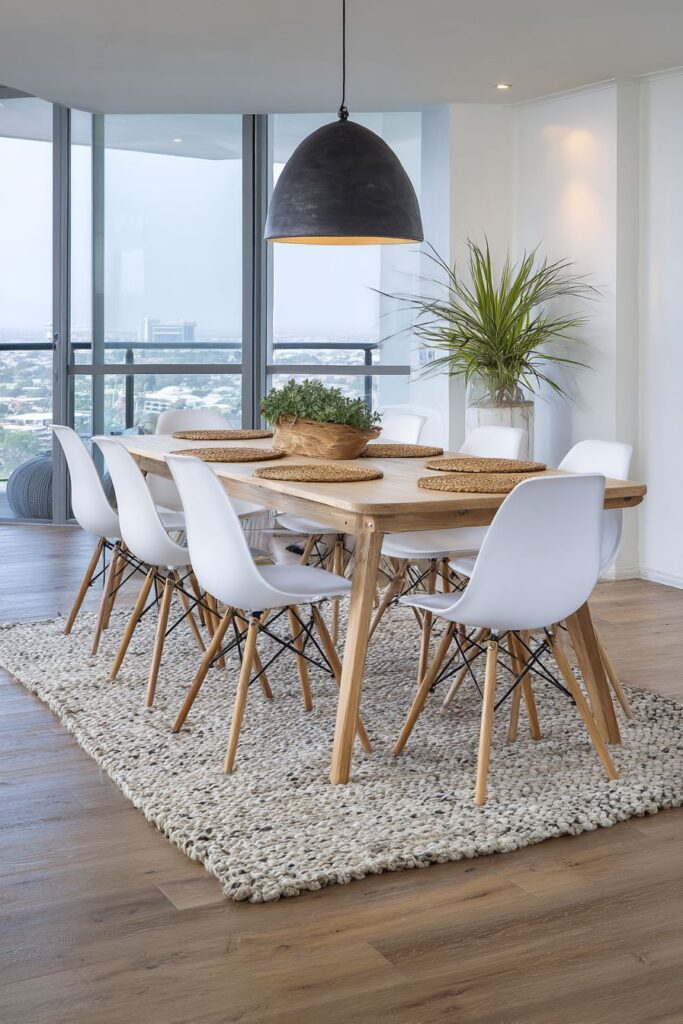
Key Design Tips:
- Choose light-colored wood furniture with clean, simple lines
- Use white or light colors for walls to maximize natural light reflection
- Select functional lighting with minimal, understated design
- Incorporate classic modern seating in neutral colors
- Keep window treatments minimal to maximize natural light intake
6. Industrial Urban Edge

Step into a dining space that celebrates the raw beauty of industrial materials and urban aesthetics, where a live-edge wooden table top mounted on black metal pipe legs creates a striking juxtaposition of organic and manufactured elements. The natural edge of the wood slab, with its irregular contours and visible grain patterns, provides a dramatic contrast to the geometric precision of the industrial pipe base, embodying the industrial design philosophy of celebrating both craftsmanship and manufacturing.
Metal dining chairs with worn leather seats surround this unique table, their weathered appearance suggesting years of use while providing comfortable seating that improves with age. The patina on both the metal frames and leather surfaces tells a story of authenticity and durability, qualities highly valued in industrial design where function and longevity take precedence over fleeting fashion trends.
Exposed brick walls and polished concrete floors provide the perfect urban backdrop, their raw textures and honest materials creating an environment that feels both sophisticated and unpretentious. These surfaces require minimal maintenance while developing character over time, embodying the industrial aesthetic’s celebration of materials in their natural state.
Edison bulb pendant lights hanging from black metal fixtures add both illumination and historical reference, their warm amber glow softening the harder edges of the industrial materials while providing focused task lighting for dining. Steel shelving units displaying books and decorative objects complete the urban loft aesthetic, offering storage solutions that double as architectural features.

Key Design Tips:
- Combine raw wood with metal elements for authentic industrial contrast
- Use exposed brick or concrete surfaces to create urban backdrop
- Install Edison bulb fixtures for warm lighting and historical reference
- Select furniture with weathered finishes that improve with age
- Incorporate steel shelving as both storage and architectural features
7. Built-in Storage Mastery
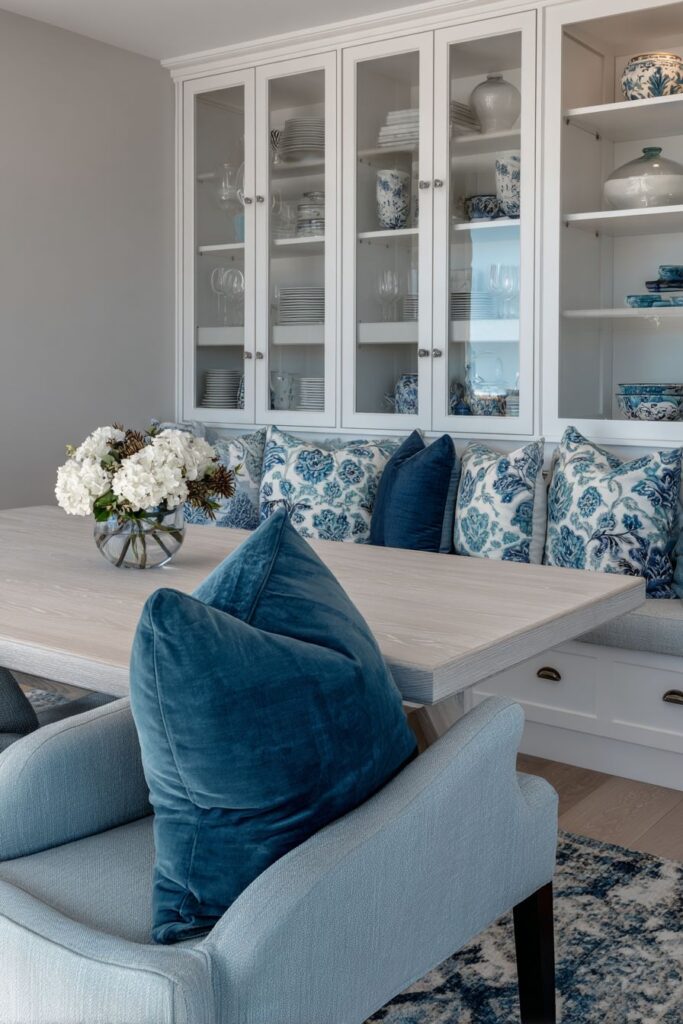
Discover how custom built-in solutions can transform your dining room into a model of efficiency and style, where every inch serves multiple purposes without compromising aesthetic appeal. The custom banquette featuring hidden storage compartments exemplifies smart design, providing comfortable seating for multiple people while concealing dining linens, seasonal decorations, or rarely used serving pieces. The coordinating throw pillows add comfort and color while maintaining the clean lines essential to built-in furniture.
Floor-to-ceiling built-in cabinets maximize vertical space, with glass upper doors displaying beautiful dishes and serving pieces while lower cabinets hide less attractive items like table runners, placemats, and cleaning supplies. This combination of open and closed storage allows homeowners to showcase their most beautiful pieces while maintaining organization and preventing clutter from overwhelming the space.
The rectangular dining table in white oak serves as the room’s centerpiece, its clean lines complementing the built-in elements without competing for attention. Modern chairs provide comfortable seating while maintaining the streamlined aesthetic that makes built-in storage solutions work effectively in dining spaces.
Professional interior design photography captures how seamlessly these storage solutions integrate with the living space functionality, demonstrating that built-ins can enhance rather than dominate a room’s design. The key lies in matching materials, maintaining consistent proportions, and ensuring that storage elements contribute to rather than detract from the overall aesthetic harmony.
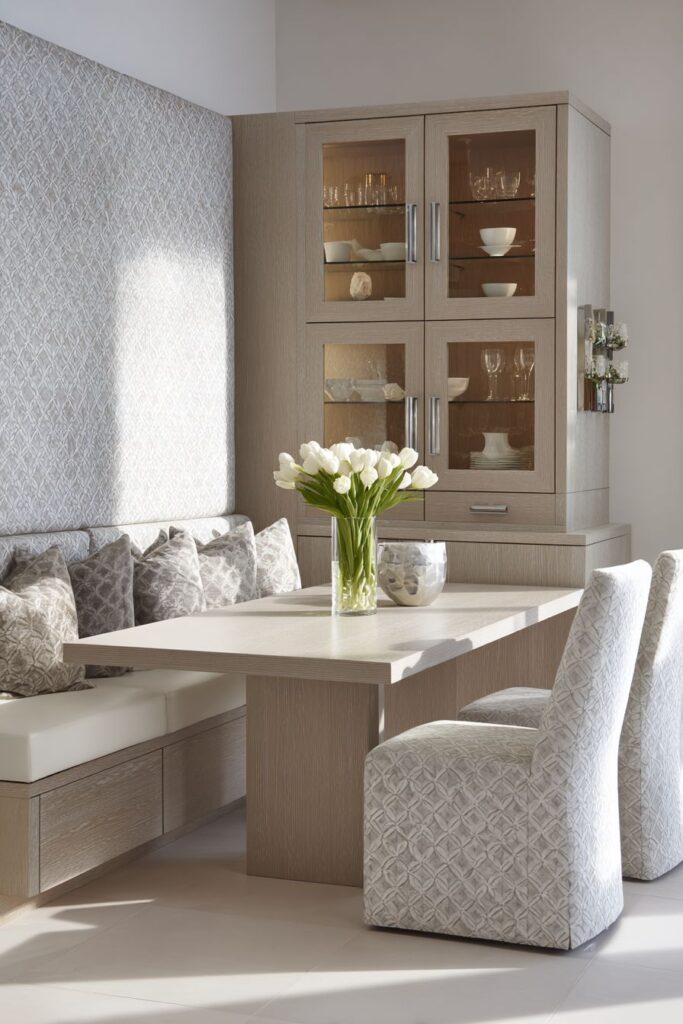
Key Design Tips:
- Design built-in seating with hidden storage compartments
- Use floor-to-ceiling cabinetry to maximize storage potential
- Mix open and closed storage to display beautiful items while hiding clutter
- Match built-in materials to existing architectural elements
- Maintain clean lines and consistent proportions throughout built-in elements
8. Open Concept Flow

Experience how thoughtful design creates seamless transitions between dining, kitchen, and living areas, where spatial boundaries dissolve while maintaining distinct functional zones. The marble-top dining table with gold-finished legs serves as both beautiful furniture and spatial anchor, defining the dining area while its luxurious materials complement adjacent spaces. The veining in the marble adds natural artistry, while the metallic legs introduce warmth and sophistication.
Upholstered dining chairs in soft blue velvet create color coordination with nearby living room elements, demonstrating how consistent color palettes can unify open-concept spaces while allowing each area to maintain its individual character. The rich texture of the velvet adds luxury and comfort while the blue hue provides a calming influence that works well in both dining and relaxation contexts.
A statement chandelier with multiple bulbs provides focused lighting over the dining area, clearly defining the space while adding dramatic visual impact that can be appreciated from the adjacent kitchen and living areas. This lighting choice serves both functional and decorative purposes, ensuring adequate task lighting while creating a focal point that enhances the entire open space.
Wide-angle professional photography captures the spacious, connected layout, showing how open-concept design can make homes feel larger and more welcoming while maintaining functionality in each zone. The key to success lies in maintaining consistent design elements while allowing each area to serve its specific purpose effectively.

Key Design Tips:
- Use statement furniture pieces to define distinct zones within open spaces
- Coordinate color palettes across adjacent areas for visual unity
- Install dramatic lighting fixtures to create focal points and define spaces
- Select materials that complement elements in neighboring areas
- Maintain consistent flooring and architectural details throughout open concepts
9. Gallery Wall Drama
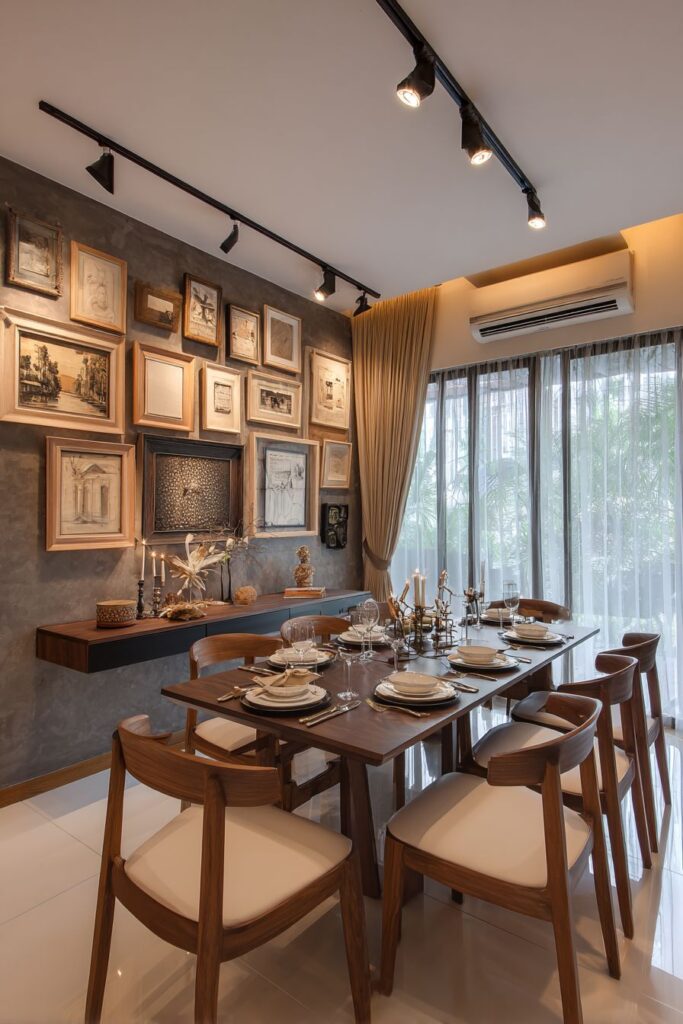
Transform your dining room into a personal art gallery where carefully curated artwork creates visual interest and reflects your unique personality and aesthetic preferences. The mixed frame sizes and diverse artwork styles above a streamlined console table demonstrate how variety can create harmony when unified by thoughtful curation and strategic placement. This approach allows homeowners to display pieces collected over time while creating a sophisticated focal point.
The main dining table in dark walnut provides a rich, grounding element that anchors the space while the cream upholstery on the matching chairs adds lightness and textural contrast. This combination of dark and light creates visual balance while ensuring that the gallery wall remains the star of the show rather than competing with heavy furniture pieces.
Track lighting illuminates both the artwork and dining surface, providing flexible illumination that can be adjusted for different occasions and activities. This professional lighting approach ensures that the art collection is properly displayed while providing adequate task lighting for dining, demonstrating how functional and aesthetic needs can be met simultaneously.
Natural light from side windows provides ambient illumination that changes throughout the day, adding another layer of visual interest as the artwork appears different under various lighting conditions. This changing quality of light keeps the gallery wall dynamic and engaging, encouraging viewers to notice new details and relationships between pieces.
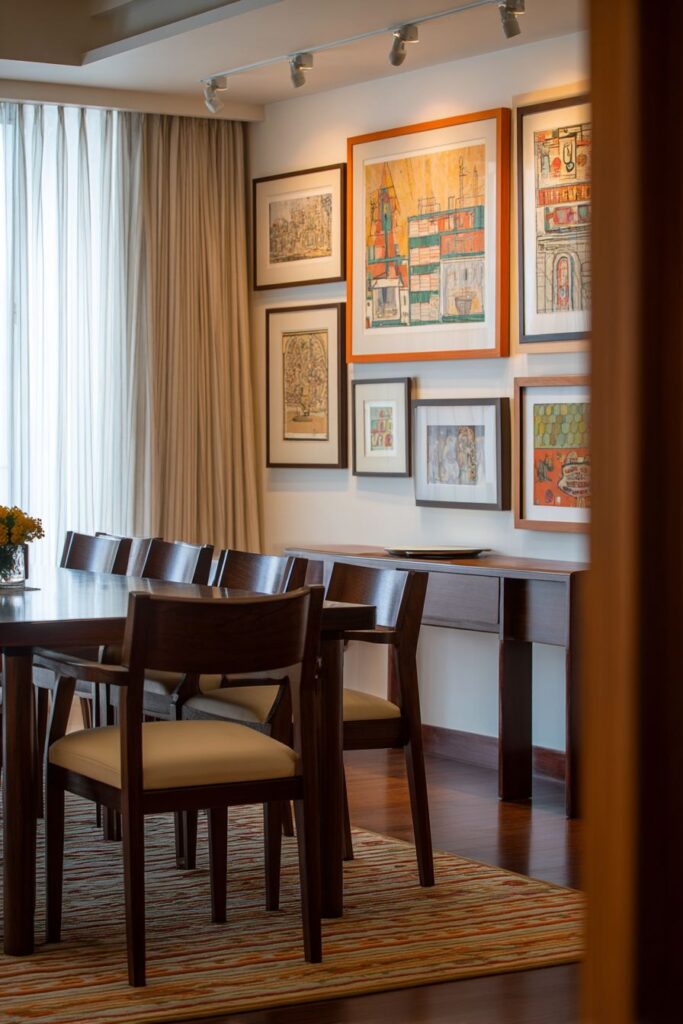
Key Design Tips:
- Mix frame sizes and styles while maintaining consistent color palette
- Use track lighting to illuminate artwork and provide task lighting
- Balance dark furniture with light upholstery and wall colors
- Create visual breathing room between artwork pieces
- Include varied artwork mediums for textural and visual interest
10. Mid-Century Modern Revival
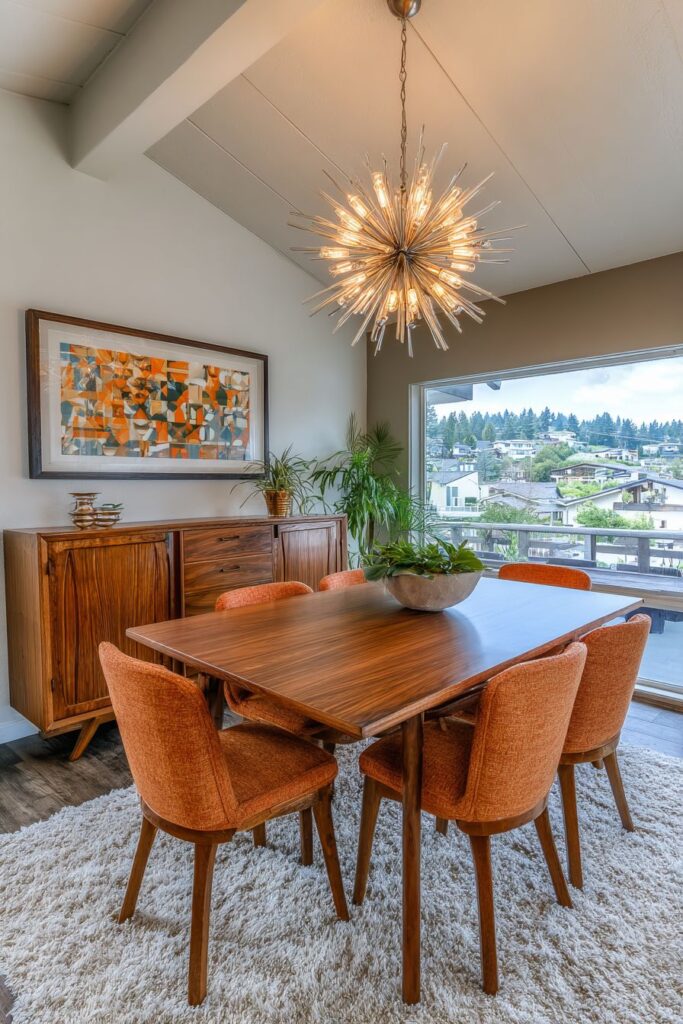
Step back into the golden age of design with a dining room that celebrates the innovative spirit and optimistic aesthetics of mid-century modernism. The teak dining table with tapered legs embodies the period’s love affair with Scandinavian craftsmanship and clean, functional design. The rich warmth of teak wood, with its distinctive grain patterns and natural oil content, creates a centerpiece that improves with age while maintaining its structural integrity and visual appeal.
The matching sideboard with sliding doors demonstrates the mid-century commitment to integrated design, where furniture pieces work together as a cohesive system rather than individual elements. These sliding doors, often featuring cane or wood grain patterns, provide hidden storage while maintaining the clean lines essential to the aesthetic. The low profile of the sideboard creates horizontal emphasis that makes the room feel more spacious.
Upholstered chairs in burnt orange fabric capture the era’s bold approach to color while complementing the warm wood tones throughout the space. This vibrant hue, popular in the 1960s and 1970s, adds energy and personality while demonstrating mid-century designers’ confidence in using saturated colors as integral design elements rather than mere accents.
The starburst chandelier provides period-appropriate lighting while serving as a sculptural focal point that embodies the space-age optimism characteristic of mid-century design. Abstract artwork in geometric patterns adorns the walls, while a shag area rug in neutral tones anchors the seating area, completing the authentic mid-century aesthetic that continues to influence contemporary design.

Key Design Tips:
- Choose teak furniture with tapered legs and clean lines
- Incorporate bold colors like orange, yellow, or turquoise in upholstery
- Use starburst or atomic-inspired lighting fixtures as focal points
- Add geometric patterns in artwork and accessories
- Include shag rugs and other period-appropriate textural elements
11. Coastal Serenity
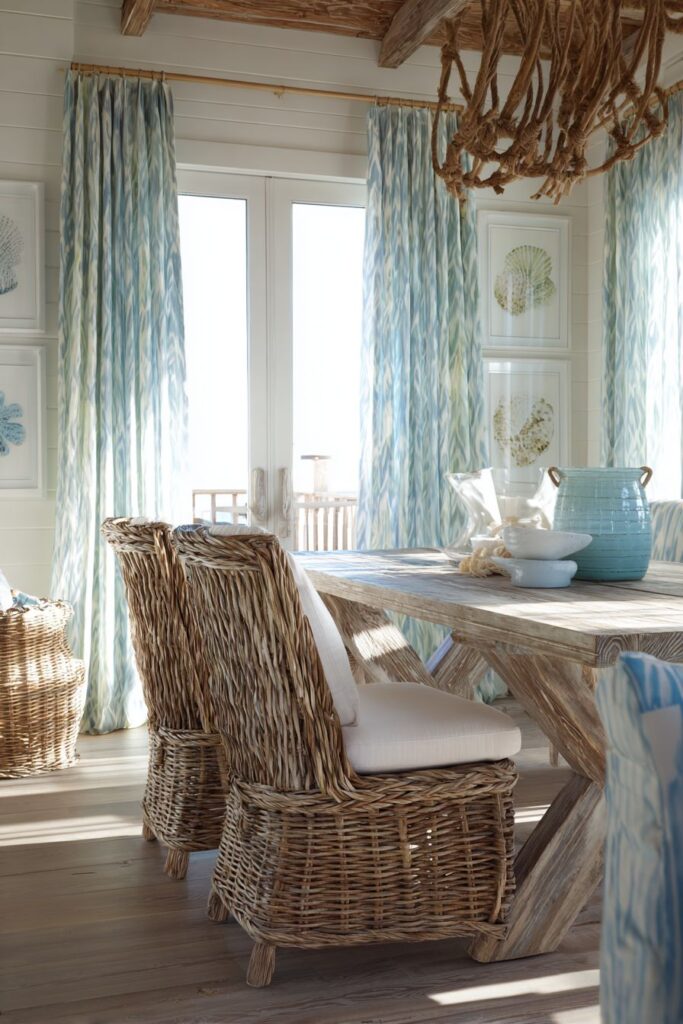
Bring the relaxed atmosphere of seaside living indoors with a dining room design that captures the essence of coastal life through carefully chosen materials and a soothing color palette. The weathered wood dining table with rope-wrapped legs immediately establishes the nautical theme while providing a sturdy surface for family meals and entertaining. The weathering process, whether natural or artificially achieved, adds character and suggests the patina that develops from years of salt air and ocean exposure.
Wicker dining chairs with white cushions contribute to the casual, outdoor-inspired aesthetic while providing comfortable seating that encourages long, leisurely meals. The natural texture of wicker adds organic interest while the white cushions maintain the fresh, clean appearance associated with coastal design. These materials are practical choices for seaside homes, as they resist humidity and maintain their appearance despite challenging environmental conditions.
The soft blue and white color palette extends throughout the room, creating a cohesive environment that references both sky and sea. This classic coastal combination provides a calming backdrop that works well with natural light while creating a timeless aesthetic that won’t quickly become dated. Ceramic table accessories and coastal artwork featuring seashells and marine life reinforce the theme without becoming overly literal or kitschy.
Natural fiber curtains filter bright sunlight while maintaining the airy, open feeling essential to coastal design. The rope and driftwood chandelier adds nautical character while providing soft, diffused lighting that enhances the relaxed atmosphere. These natural materials age gracefully and develop character over time, embodying the coastal philosophy of embracing natural processes and imperfection.
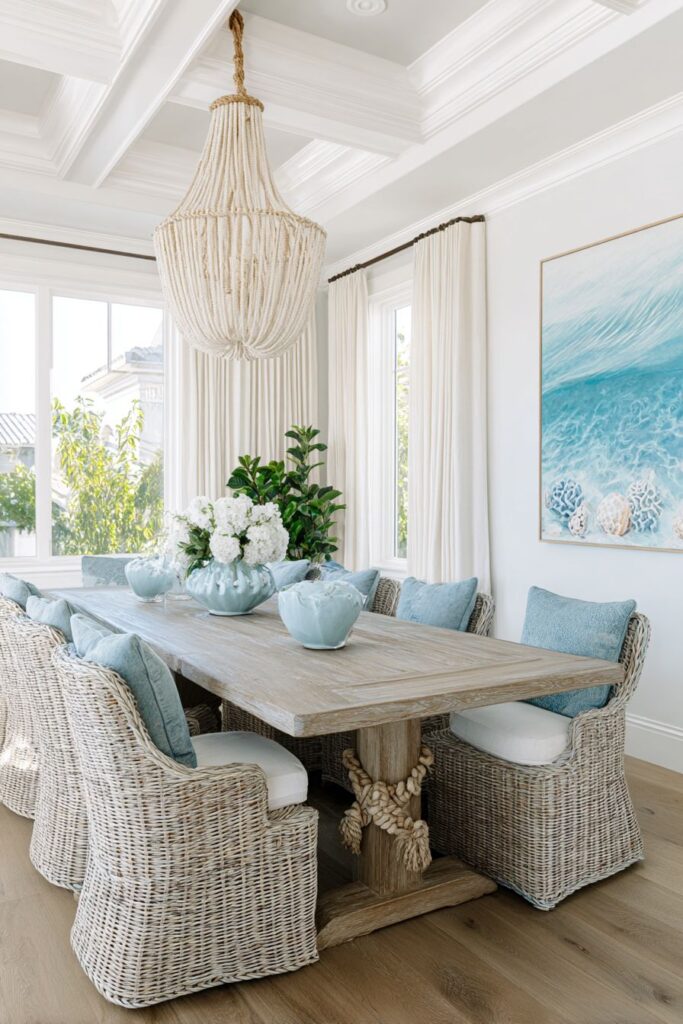
Key Design Tips:
- Use weathered wood furniture to create authentic coastal patina
- Incorporate rope details in furniture legs and light fixtures
- Choose wicker seating with light-colored cushions for comfort and style
- Maintain a blue and white color palette with natural accent materials
- Display marine-themed artwork and accessories without overwhelming the space
12. Rustic Lodge Appeal
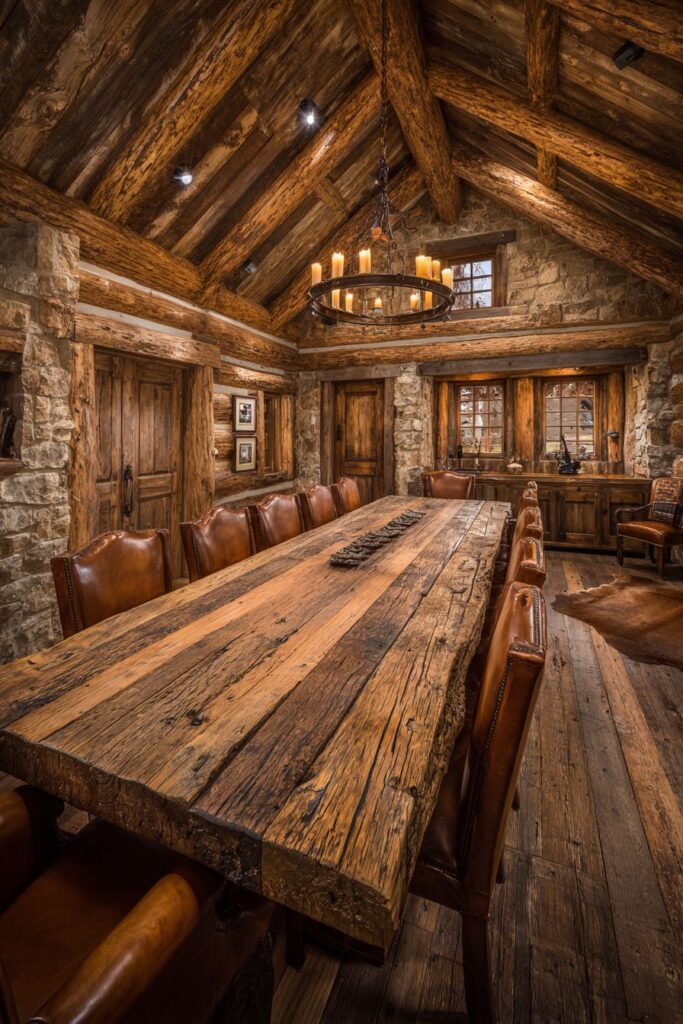
Create a dining space that embodies the rugged beauty and honest craftsmanship of mountain lodge design, where a massive solid wood dining table made from reclaimed barn wood serves as both furniture and conversation piece. The visible nail holes, weathering marks, and natural imperfections in the wood tell stories of the structure’s agricultural past, bringing historical significance and authentic character that cannot be manufactured or replicated.
Log cabin-style chairs with leather seats provide authentic seating that improves with age and use, their sturdy construction reflecting the practical needs of mountain living while adding to the overall rustic aesthetic. The natural variations in the wood grain and the rich patina of the leather create visual interest while ensuring comfort for extended family gatherings and holiday celebrations.
A wrought iron chandelier with candle-style bulbs illuminates the space with warm, flickering light that enhances the cozy cabin atmosphere while providing adequate task lighting for dining activities. The hand-forged details in the metalwork demonstrate traditional craftsmanship skills while the candle-inspired design references pre-electric lighting methods that add to the historical authenticity.
The stone accent wall and wide-plank wooden floors enhance the cabin atmosphere while providing durable surfaces that can withstand the wear and tear of active family life. These natural materials age gracefully and develop character over time, embodying the rustic philosophy of embracing natural processes and celebrating the beauty found in weathering and wear.
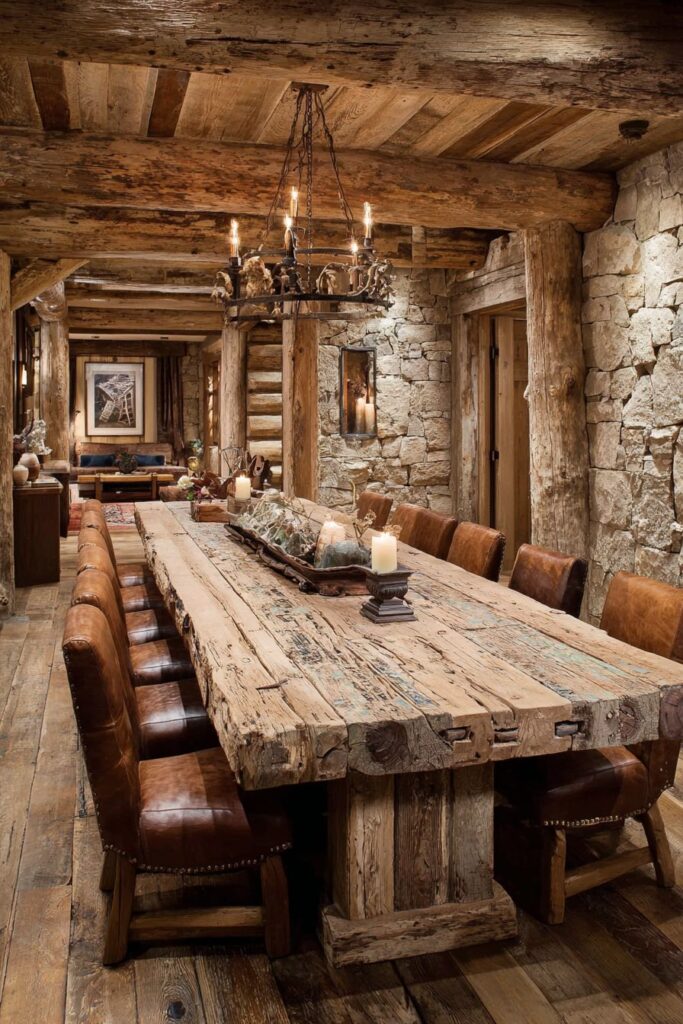
Key Design Tips:
- Select furniture made from reclaimed wood with visible history and character
- Use wrought iron lighting fixtures with candle-style bulbs for authentic ambiance
- Incorporate stone surfaces for texture and durability
- Choose leather seating that improves with age and use
- Display rustic accessories like antlers, vintage tools, or Native American crafts
13. Minimalist Zen Calm
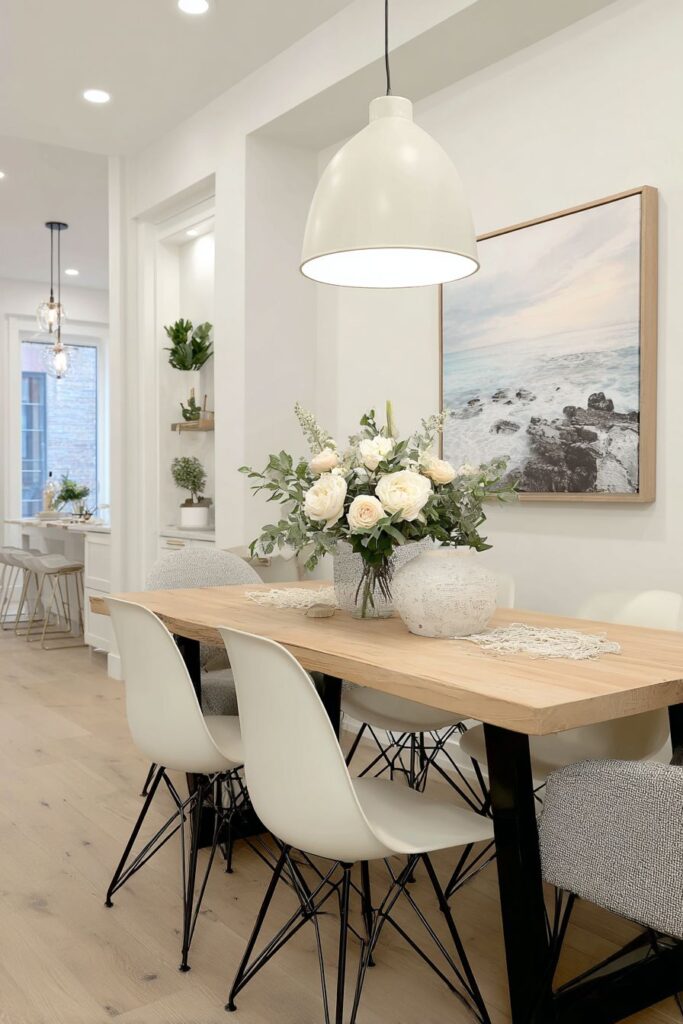
Enter a dining space that embodies the minimalist philosophy of “less is more,” where every element serves a purpose while contributing to an atmosphere of serene simplicity. The rectangular table in blonde wood with hairpin legs demonstrates how restraint in design can create powerful visual impact through clean lines and quality materials. The light wood tone adds warmth without overwhelming the space, while the hairpin legs provide structural support with minimal visual weight.
Four matching chairs with clean geometric lines surround the table, their simple forms emphasizing function over ornamentation while maintaining visual consistency throughout the space. The repetition of identical elements creates rhythm and harmony while avoiding the visual chaos that can result from too many different design elements competing for attention.
The neutral color palette extends throughout the room, with white walls and light hardwood floors providing a calm backdrop that allows the quality of individual pieces to shine through. This monochromatic approach eliminates visual distractions while creating a sense of spaciousness and tranquility that encourages contemplation and peaceful dining experiences.
A single pendant light in matte white provides focused illumination while maintaining the clean aesthetic through its simple, unadorned form. One carefully chosen piece of abstract art serves as the sole wall decoration, demonstrating how restraint in accessories can make each selected item more impactful and meaningful within the overall composition.
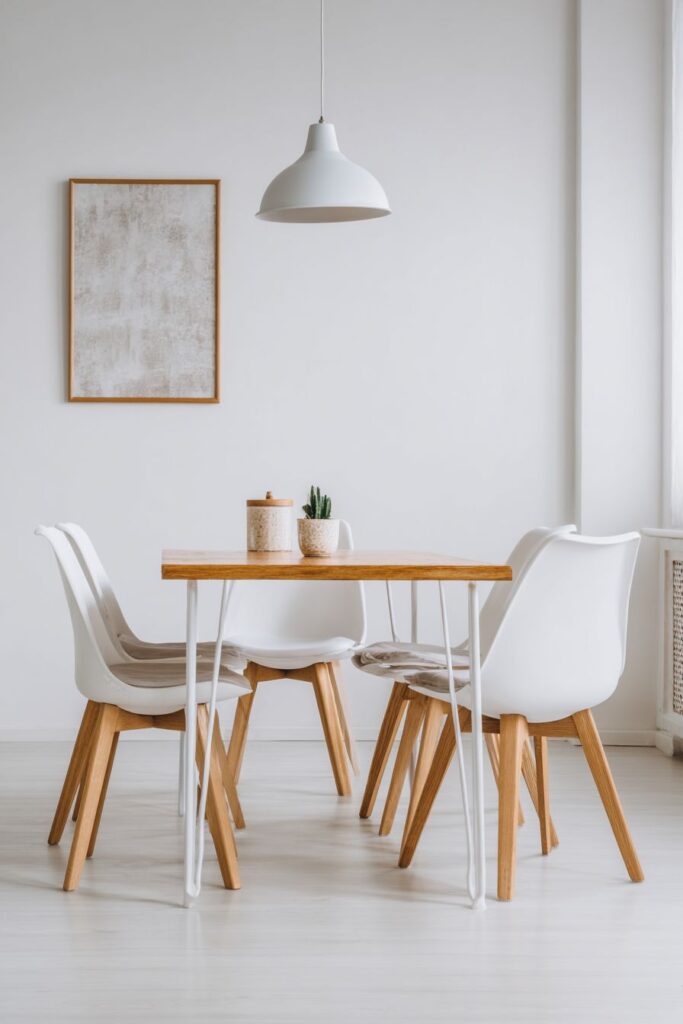
Key Design Tips:
- Choose furniture with clean lines and minimal ornamentation
- Use a monochromatic color palette to create visual calm
- Select one statement piece of art rather than multiple smaller items
- Maintain consistent geometric forms throughout furniture selections
- Keep surfaces clear and uncluttered to emphasize the beauty of empty space
14. Eclectic Vintage Mix
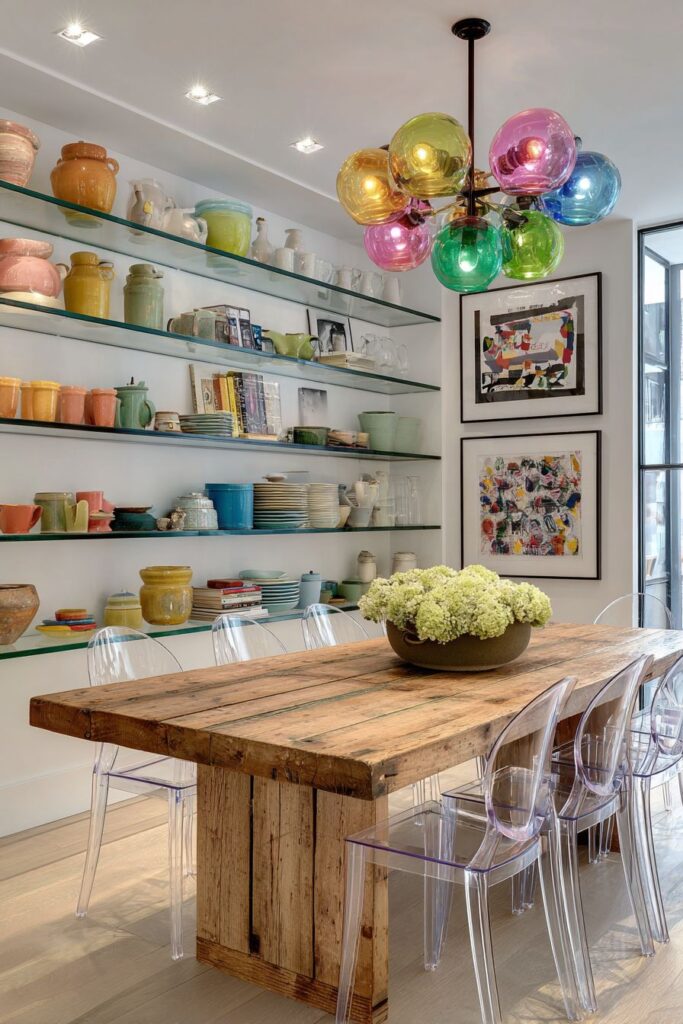
Celebrate the art of successful mixing with a dining room that demonstrates how vintage and contemporary elements can coexist beautifully when united by thoughtful curation and a confident design eye. The antique farm table serves as a historical anchor, its weathered surfaces and traditional construction methods providing authenticity and character that grounds the entire space. This piece brings gravitas and storytelling power that new furniture simply cannot replicate.
Modern acrylic chairs surrounding the vintage table create a striking juxtaposition that highlights the best qualities of both eras. The transparency of the acrylic allows the table’s details to remain visible while adding contemporary sophistication and visual lightness that prevents the space from feeling too heavy or antiquated. This combination demonstrates how different periods can enhance rather than compete with each other.
Colorful vintage pottery displayed on open shelving adds personality and visual interest while showcasing the homeowner’s collecting interests and travels. These pieces, each with their own history and craftsmanship story, create a personal narrative that makes the space unique and memorable. The varied colors and forms add energy while maintaining the eclectic theme.
Contemporary abstract paintings create visual interest on the walls while providing color coordination that ties together the diverse elements throughout the space. The unique vintage chandelier with colored glass shades provides ambient lighting while serving as a sculptural focal point that bridges the gap between old and new aesthetics.
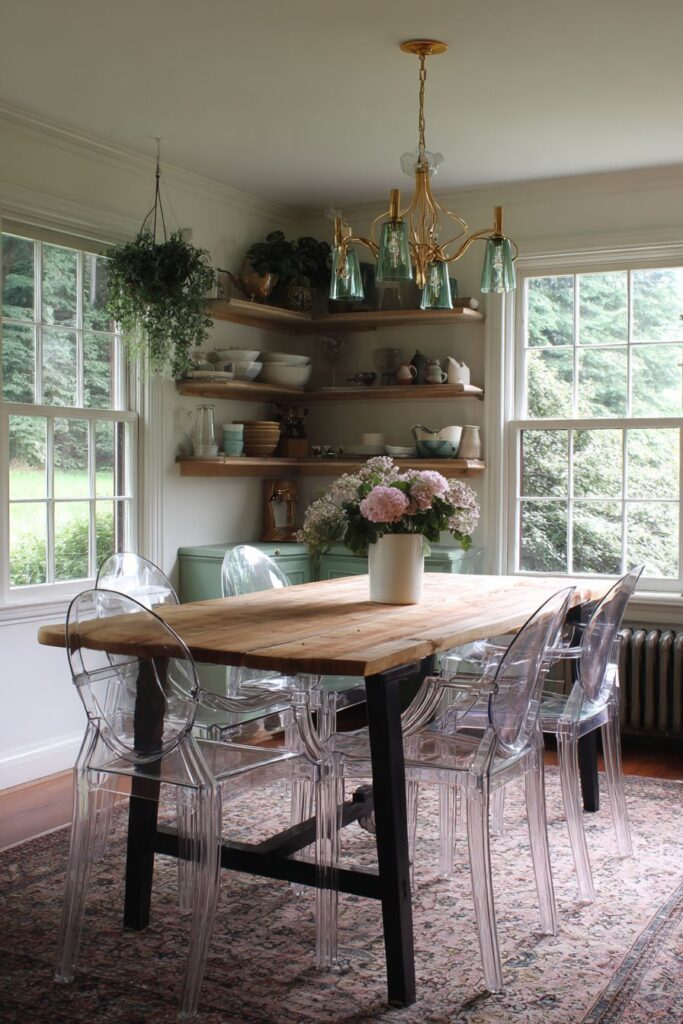
Key Design Tips:
- Mix furniture from different time periods with confidence
- Use transparent materials to lighten visually heavy vintage pieces
- Display collections of pottery or art objects for personality
- Unite diverse elements through consistent color coordination
- Choose lighting fixtures that bridge different design periods
15. Natural Organic Living

Connect with nature through a dining room design that celebrates organic materials and living elements, creating a space that feels like a natural extension of the outdoor environment. The live-edge walnut dining table showcasing the tree’s natural contours serves as both functional furniture and natural sculpture, its irregular edges and visible wood grain patterns providing a direct connection to the forest from which it came.
Dining chairs featuring woven rattan backs and natural linen cushions contribute to the organic aesthetic while providing comfortable seating that breathes and ages gracefully. The natural materials develop character over time while maintaining their structural integrity, embodying the sustainable design philosophy that values longevity over temporary fashion trends.
Potted plants in various sizes create a garden-like atmosphere that brings life and seasonal change into the dining space. These living elements provide natural air purification while adding color, texture, and visual movement that keeps the space dynamic and engaging throughout the year. The varied heights and forms of the plants create visual rhythm while softening the harder edges of furniture pieces.
The natural stone accent wall adds organic texture and visual weight while providing a neutral backdrop that complements the wood and plant elements. A jute area rug anchors the space with additional natural texture while defining the dining zone within larger open-concept layouts. Large windows provide abundant natural light that highlights the wood grain and plant details while connecting the interior to the outdoor environment.
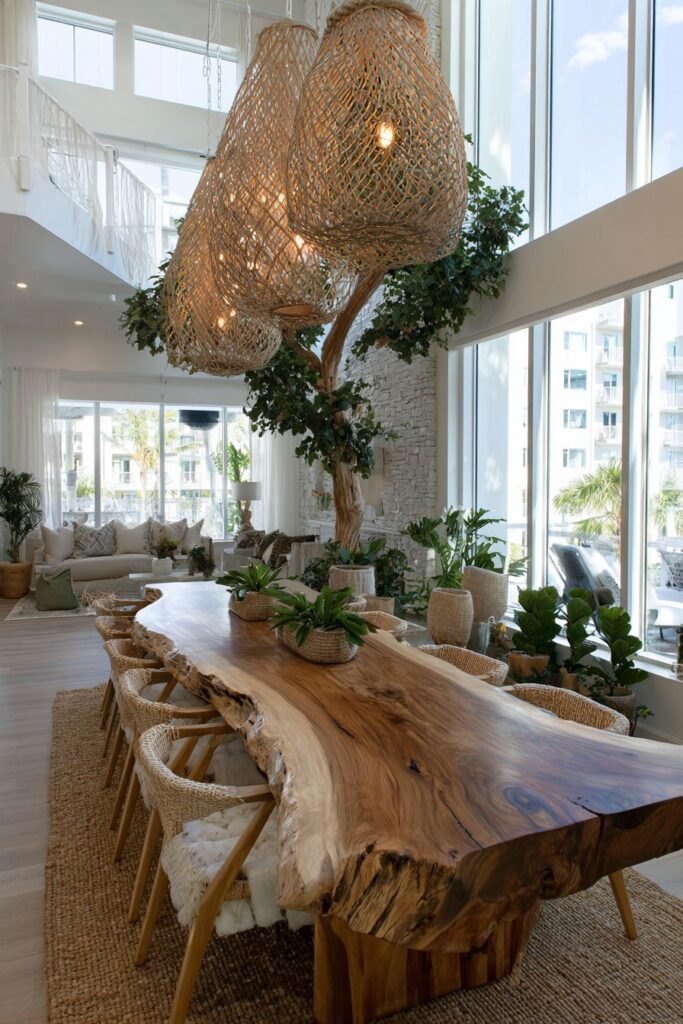
Key Design Tips:
- Choose furniture that showcases natural wood grain and live edges
- Incorporate multiple plants of varying sizes for garden-like atmosphere
- Use natural fiber rugs and upholstery materials
- Add stone or other organic wall treatments for texture
- Maximize natural light to highlight organic materials and living elements
16. Formal Traditional Grandeur
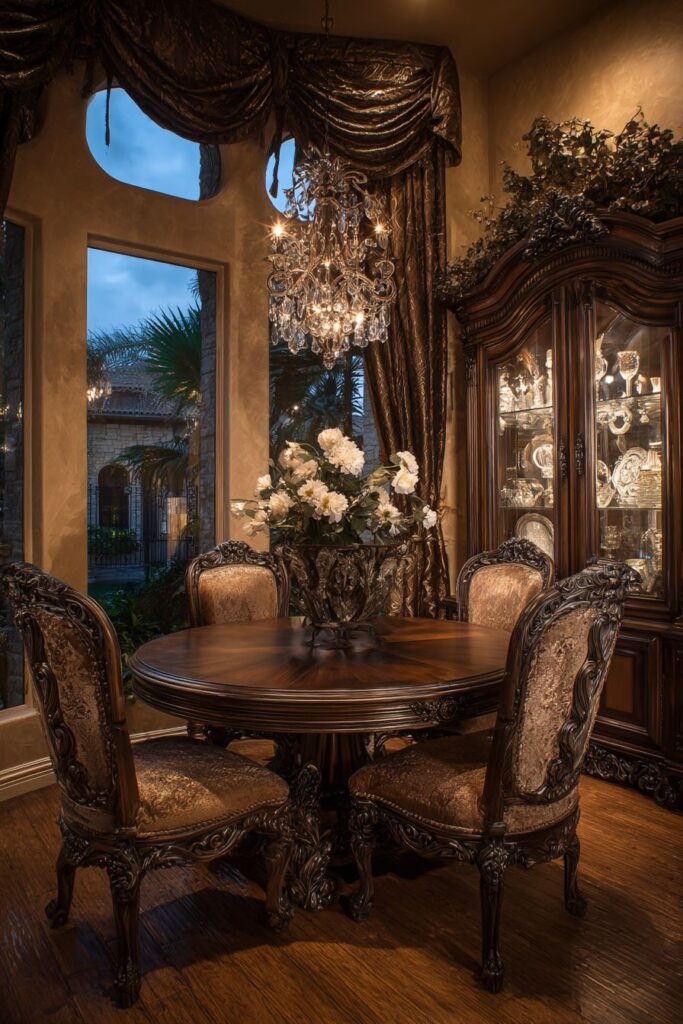
Experience the pinnacle of formal dining elegance with a room designed to honor classical traditions and celebrate special occasions with appropriate grandeur. The ornate mahogany dining table with its carved pedestal base represents centuries of furniture-making tradition, where skilled craftsmen spent countless hours creating details that demonstrate both technical skill and artistic vision. The rich, dark wood provides a substantial foundation that commands respect and admiration.
High-back upholstered chairs in rich fabric surround this magnificent table, their imposing presence and luxurious materials creating an atmosphere of importance and ceremony. The careful attention to proportion and detail in these chairs reflects the traditional belief that dining furniture should be both functional and beautiful, serving as a backdrop for life’s most significant celebrations and gatherings.
An impressive china cabinet with mullioned glass doors displays fine porcelain and crystal, transforming functional storage into a showcase for beautiful objects that represent family history and cultural refinement. These pieces, often passed down through generations, add personal meaning and historical continuity to the formal dining experience.
Heavy draperies in deep jewel tones frame tall windows while providing privacy and light control appropriate for evening entertaining. The traditional crystal chandelier provides elegant illumination while serving as a magnificent focal point that demonstrates the homeowner’s commitment to quality and beauty in all aspects of the dining experience.
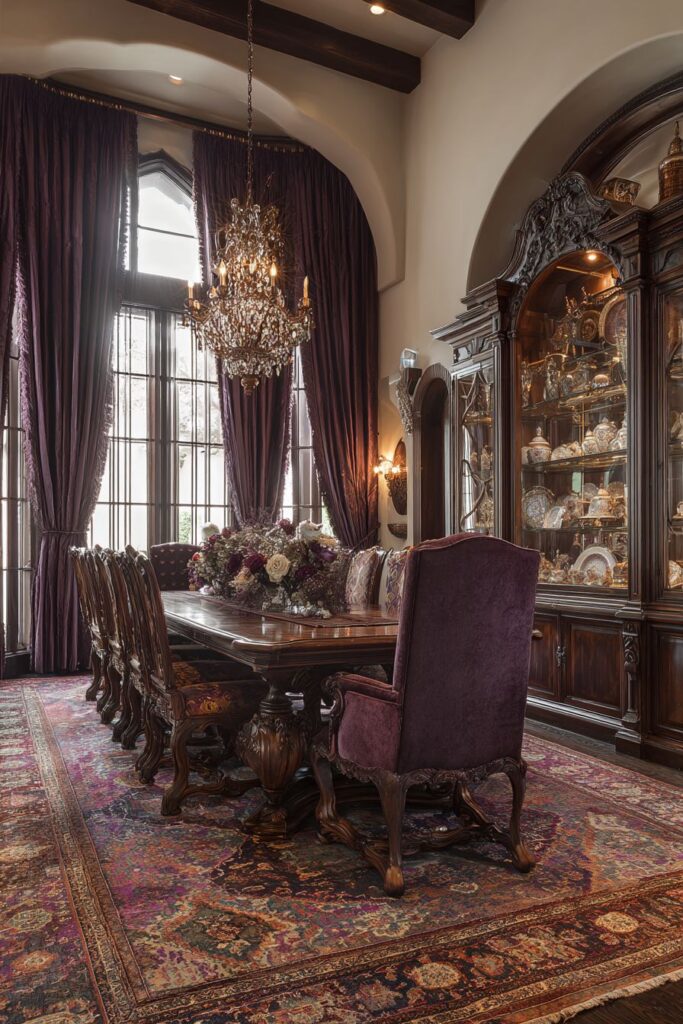
Key Design Tips:
- Invest in quality mahogany or cherry furniture with hand-carved details
- Use crystal chandeliers for dramatic focal points and elegant lighting
- Display fine china and crystal in glass-front cabinetry
- Choose rich fabrics in deep colors for upholstery and window treatments
- Maintain symmetrical arrangements and classical proportions throughout
17. Casual Family Comfort
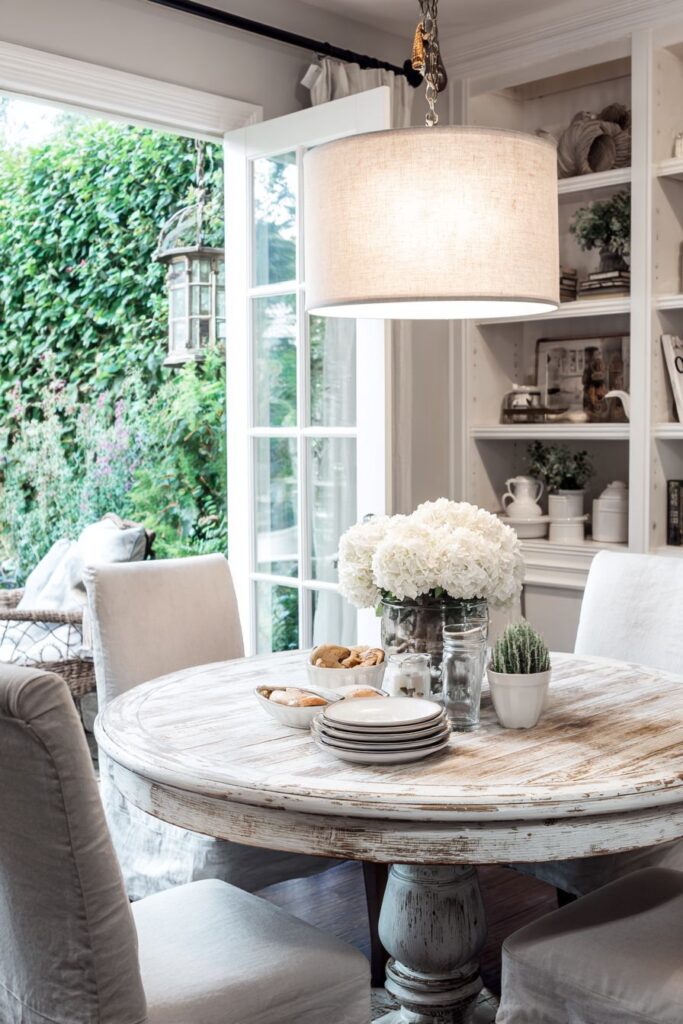
Create a dining space that prioritizes comfort and practicality while maintaining style and visual appeal perfect for everyday family life. The round farmhouse table in distressed white finish provides a welcoming gathering place where the weathered surface shows character while hiding the inevitable marks and scratches that come with active family use. The circular shape encourages conversation and eliminates sharp corners that could be problematic in busy family environments.
Comfortable upholstered chairs in washable fabric covers demonstrate how style and practicality can coexist successfully in family-friendly dining spaces. The removable covers allow for easy cleaning and seasonal updates while the underlying chair construction provides long-term durability. This approach acknowledges the reality of family life while refusing to compromise on comfort or appearance.
Open shelving displays everyday dishes and casual serving pieces, making frequently used items easily accessible while adding visual interest through the display of colorful ceramics and glassware. This practical storage solution eliminates the need for formal china cabinets while celebrating the beauty found in everyday objects when thoughtfully arranged and displayed.
A simple drum shade pendant provides practical lighting that illuminates the table surface adequately for homework, crafts, and meal preparation. Natural wood floors and casual window treatments maintain the relaxed, family-friendly atmosphere while providing durable surfaces that can withstand the demands of active household life.
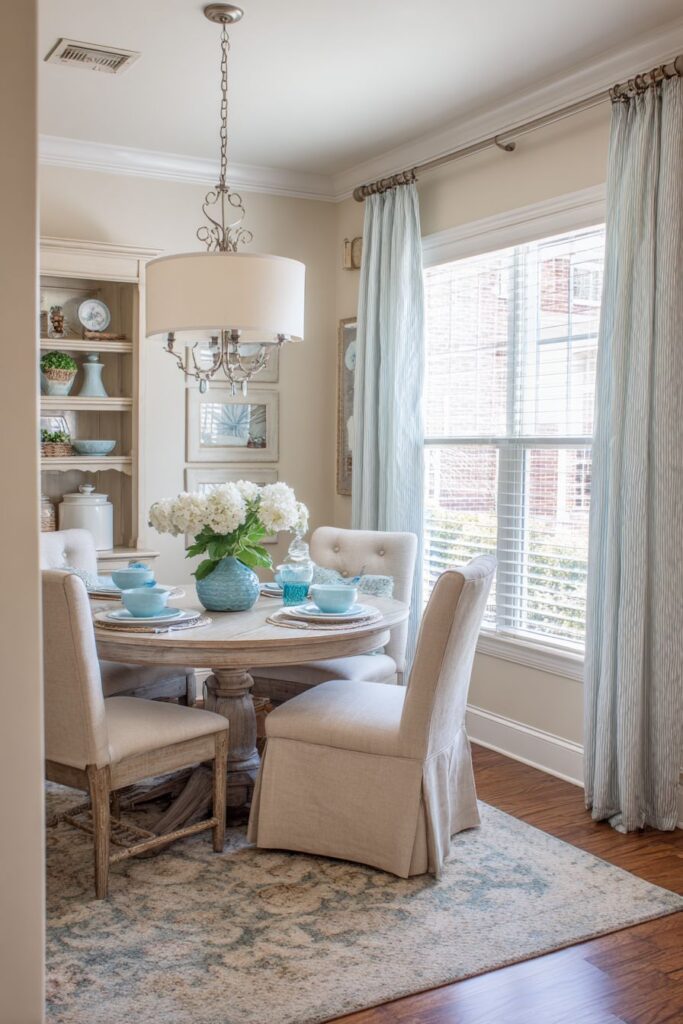
Key Design Tips:
- Choose furniture with durable finishes that hide wear and scratches
- Use washable fabrics for easy maintenance and seasonal updates
- Display everyday dishes on open shelving for both function and beauty
- Install practical lighting that serves multiple family activities
- Select flooring and window treatments that require minimal maintenance
18. Flexible Mixed Seating
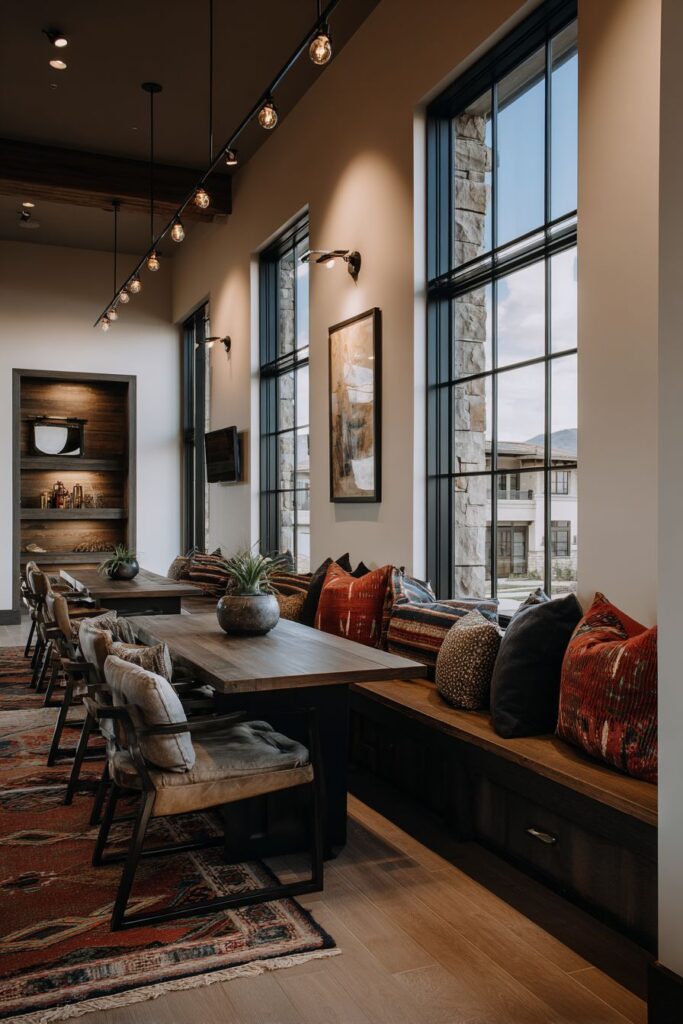
Discover how creative seating arrangements can maximize functionality while adding visual interest and accommodating various family sizes and dining occasions. The long dining table accommodated by both traditional dining chairs and a built-in bench with storage underneath demonstrates how flexible thinking can solve multiple design challenges simultaneously while creating a more dynamic and interesting visual composition.
Chairs alternating between upholstered seats and wooden backs add variety while maintaining cohesion through consistent proportions and coordinated finishes. This mixing approach allows homeowners to accommodate different comfort preferences while creating visual rhythm that keeps the space engaging rather than monotonously uniform.
Colorful throw pillows on the bench add personality and seasonal flexibility while providing additional comfort for longer dining sessions. These easily changeable accessories allow the space to evolve with changing tastes and seasons while the underlying furniture remains constant. The storage compartment beneath the bench provides practical space for linens, games, or seasonal items.
String lights overhead create intimate ambiance for evening dining while adding whimsical charm that appeals to both children and adults. This casual lighting approach contrasts beautifully with natural light from multiple windows that provides daytime illumination, demonstrating how layered lighting can transform a space for different occasions and moods.
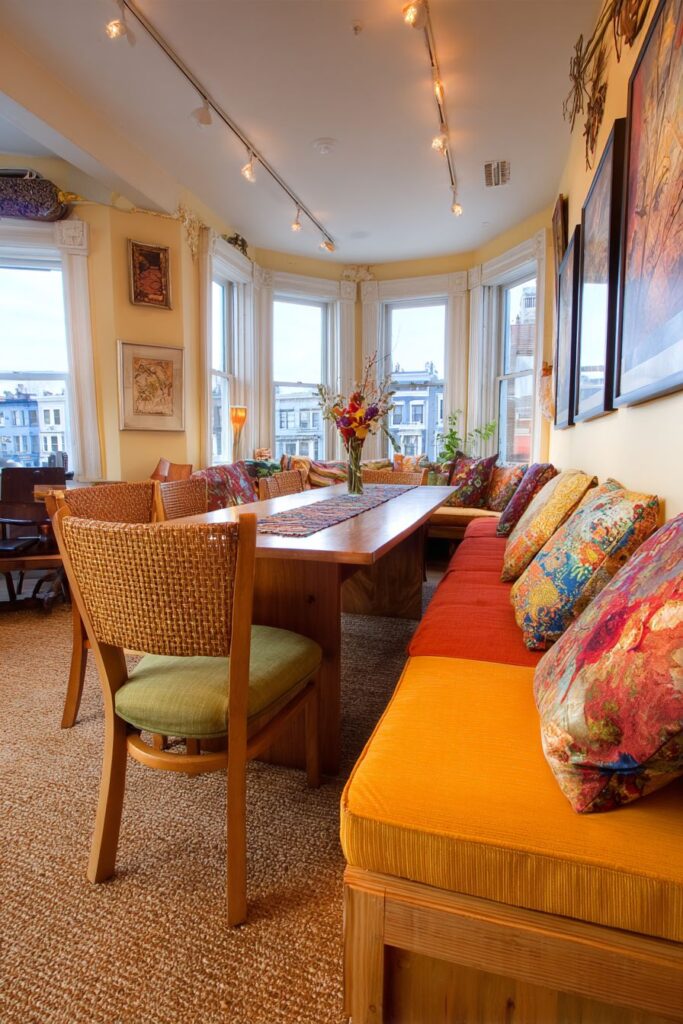
Key Design Tips:
- Combine bench seating with traditional chairs for flexibility and visual interest
- Use coordinated but not matching chair styles for dynamic seating arrangements
- Add colorful pillows and accessories for personality and seasonal changes
- Install casual lighting like string lights for intimate evening ambiance
- Include storage solutions within seating elements for maximum functionality
19. Statement Wallpaper Drama

Make a bold design statement with wallpaper that transforms your dining room into a work of art while demonstrating how one dramatic element can define an entire space’s personality. The statement wallpaper with bold botanical prints covering one accent wall creates immediate visual impact while providing a sophisticated backdrop that elevates the entire room’s aesthetic appeal. The large-scale patterns add grandeur while the botanical motifs bring natural elements indoors.
The simple wooden dining table allows the wallpaper to take center stage without competing for attention, demonstrating the importance of restraint when working with bold patterns. The table’s clean lines and natural wood grain provide textural contrast while maintaining the organic theme established by the botanical wallpaper prints.
Neutral dining chairs in coordinated tones ensure that the wallpaper remains the focal point while providing comfortable seating that doesn’t clash with the bold patterns. This careful color coordination prevents visual chaos while allowing the dramatic wall treatment to have maximum impact without overwhelming the diners or making the space feel cramped or busy.
Brass lighting fixtures coordinate with metallic accents in the wallpaper pattern, creating visual continuity while adding warmth and sophistication. Natural wood floors and simple window treatments keep other elements understated, following the design principle that when one element is bold and dramatic, other components should remain relatively quiet and supportive.
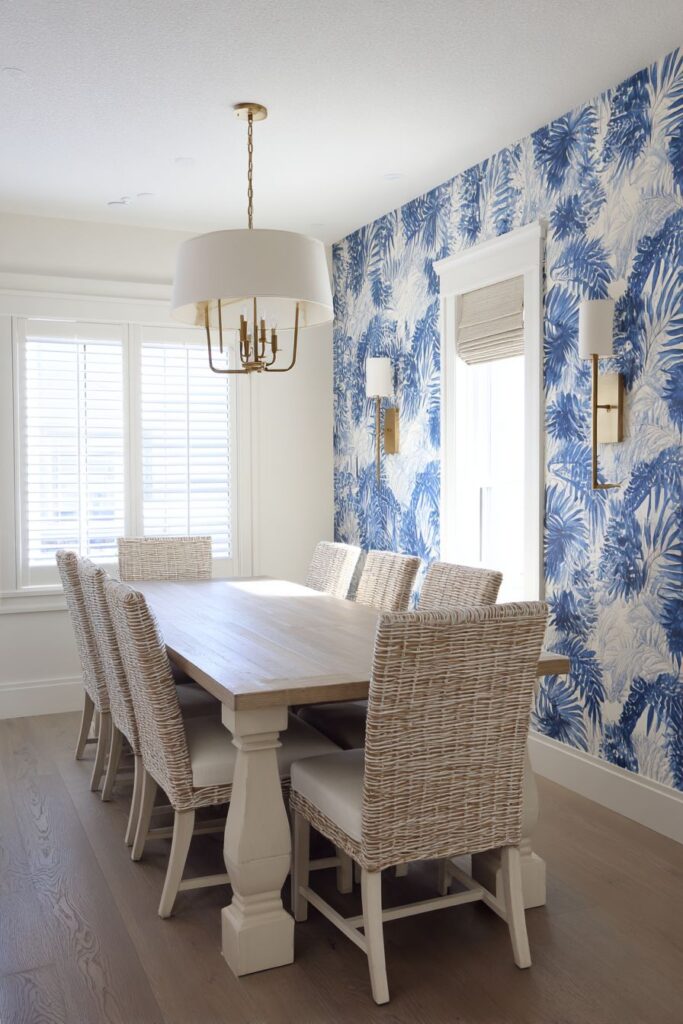
Key Design Tips:
- Use bold wallpaper on one accent wall rather than throughout entire room
- Choose simple furniture that complements rather than competes with dramatic patterns
- Coordinate lighting fixtures with metallic accents in wallpaper designs
- Keep other decorative elements minimal when using statement wallpaper
- Select botanical or geometric patterns for sophisticated impact
20. Light-Maximizing Transparency
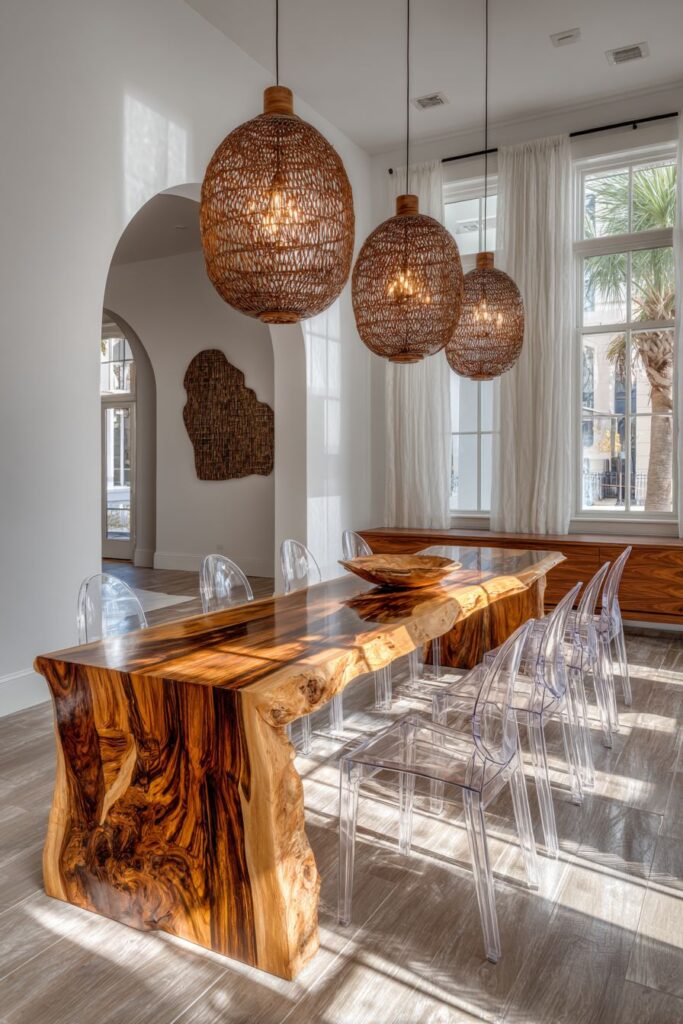
Transform your dining space into a bright, airy haven that celebrates natural light through transparent and reflective materials that enhance rather than obstruct illumination. The glass-top dining table serves as both functional furniture and light-enhancing element, allowing illumination to flow through rather than being blocked by solid surfaces. The transparency creates visual lightness while maintaining the practical surface area needed for dining activities.
Transparent acrylic chairs maintain visual openness while providing necessary seating, their clear construction ensuring that natural light can reach every corner of the room without obstruction. These chairs appear to float in space, creating a sense of openness and spaciousness that makes the dining area feel larger and more connected to its surroundings.
Large unobstructed windows on multiple walls flood the space with daylight from various angles throughout the day, creating an ever-changing light quality that keeps the space dynamic and engaging. This abundance of natural light eliminates the heavy, closed-in feeling that can plague dining rooms with limited window access while providing energy-saving illumination for most daytime activities.
Sheer curtains provide privacy without blocking light, their translucent quality filtering harsh sunlight while maintaining the bright, open atmosphere. Light-colored walls and floors reflect and amplify the natural illumination, creating a bright, energizing environment that makes meals feel fresh and invigorating rather than heavy or formal.
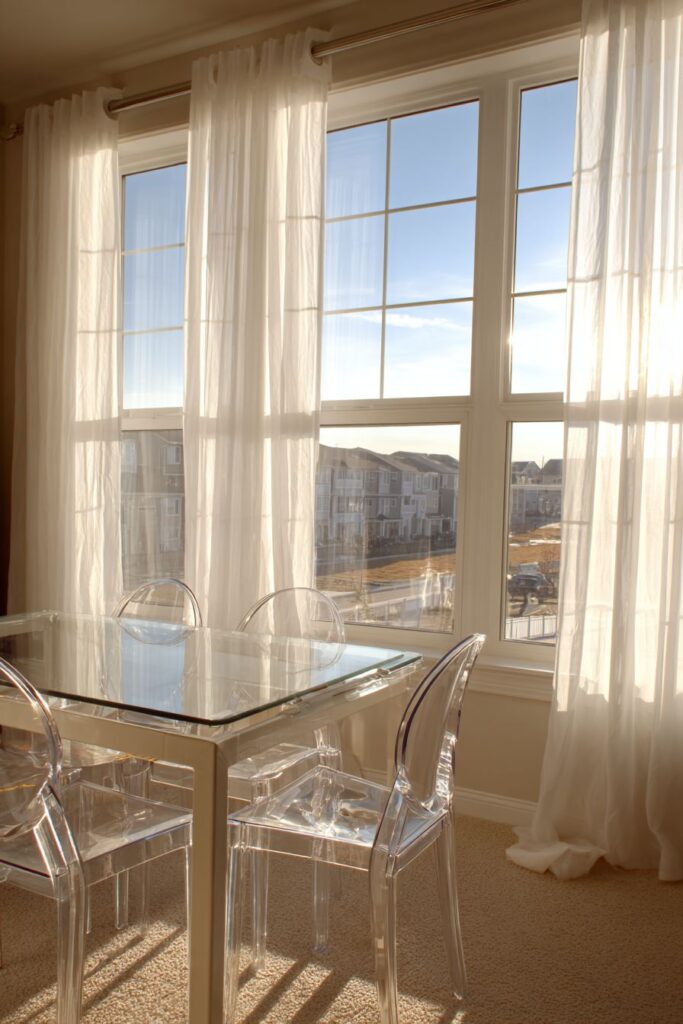
Key Design Tips:
- Choose glass or acrylic furniture to maximize light transmission
- Use transparent seating to maintain visual openness
- Install sheer window treatments that filter rather than block light
- Paint walls and ceilings in light colors to reflect and amplify illumination
- Position mirrors strategically to bounce light throughout the space
Why These Dining Room Designs Are the Best
These twenty dining room decor concepts represent the finest examples of interior design excellence because they address the diverse needs and preferences of modern homeowners while demonstrating timeless design principles. Modern contemporary dining rooms excel in their clean sophistication and material quality, making them perfect for homeowners who appreciate minimalist aesthetics and cutting-edge design trends. The traditional formal designs provide unmatched elegance and grandeur, ideal for those who value classical beauty and time-honored craftsmanship in their dining spaces.
Small space solutions demonstrate innovative thinking that maximizes functionality without sacrificing style, proving that size limitations need not compromise design quality. These space-saving dining room ideas incorporate clever storage solutions and multipurpose furniture that makes every square foot count while maintaining visual appeal. Farmhouse and rustic designs offer authentic charm and warmth that creates welcoming environments perfect for family gatherings and casual entertaining.
The Scandinavian and minimalist approaches provide serene, clutter-free environments that promote peaceful dining experiences while showcasing the beauty of simplicity and functional design. Industrial and eclectic styles appeal to homeowners who appreciate unique, personalized spaces that reflect individual personality and creative vision through bold material choices and unexpected combinations.
Natural and organic designs connect dining spaces to the outdoors while promoting sustainability and environmental consciousness through the use of eco-friendly materials and living elements. Storage-focused solutions address practical needs while maintaining aesthetic appeal, proving that functional design can be beautiful and inspiring.
These dining room concepts succeed because they balance aesthetic appeal with practical functionality, ensuring that beautiful spaces also serve the real needs of contemporary families. Whether you prefer formal elegance or casual comfort, bold statements or subtle sophistication, these designs provide proven approaches that have been refined through years of professional interior design experience and homeowner satisfaction.
Conclusion
Creating the perfect dining room involves understanding how different design elements work together to support both functional needs and aesthetic preferences. These twenty dining room decor ideas demonstrate that successful interior design comes from thoughtful consideration of materials, lighting, color, texture, and spatial arrangement rather than following rigid style rules or expensive trends.
Whether your space is large or small, formal or casual, traditional or contemporary, the key to success lies in choosing elements that reflect your lifestyle while creating an atmosphere that encourages gathering, conversation, and memorable meal experiences. Each design approach offers unique benefits and can be adapted to suit different budgets, architectural constraints, and personal preferences.
Remember that the best dining room is one that serves your family’s needs while bringing joy and beauty to everyday life. Use these ideas as inspiration to create your own unique dining space that will provide years of comfortable, beautiful dining experiences for family and friends alike.
